
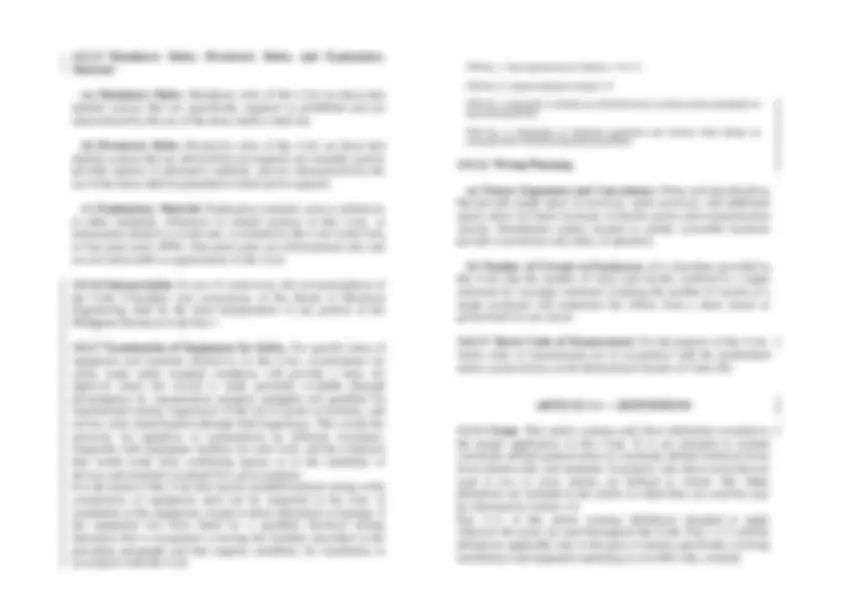
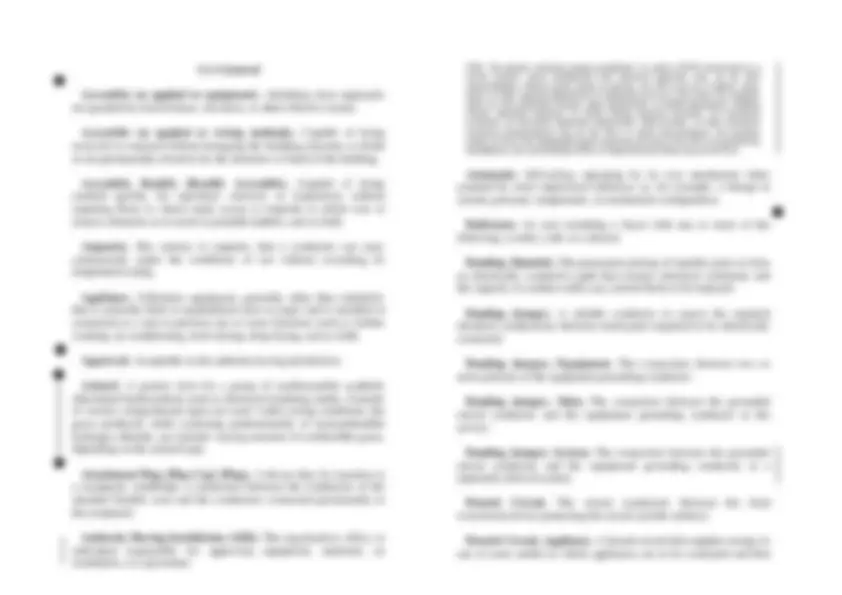
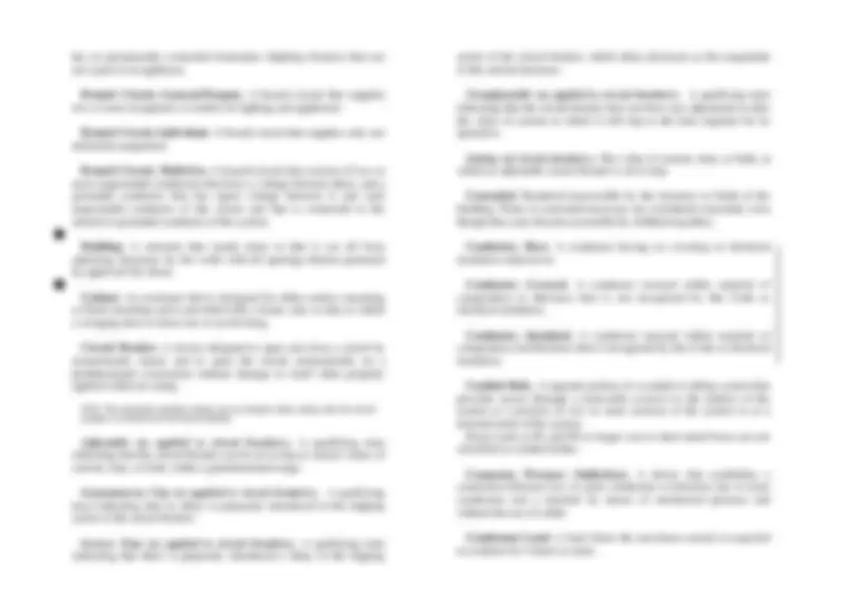
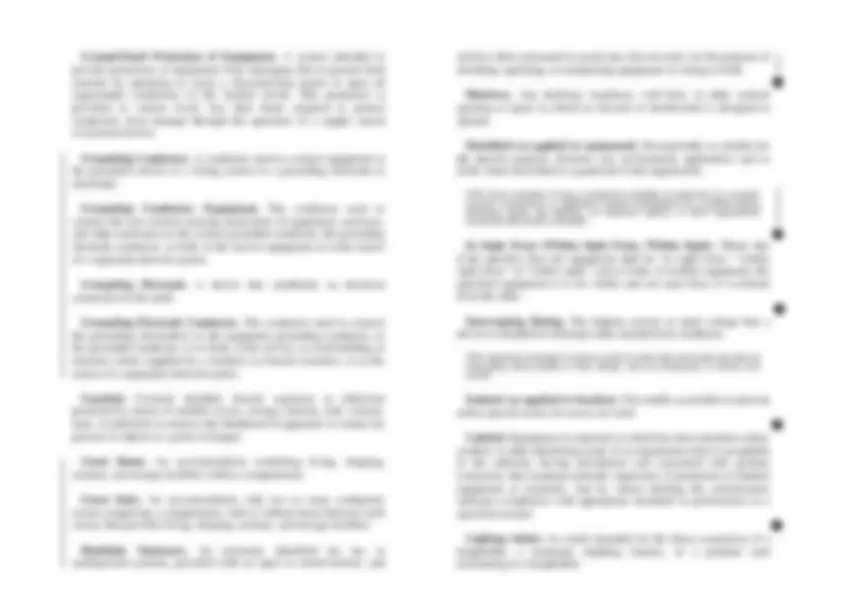
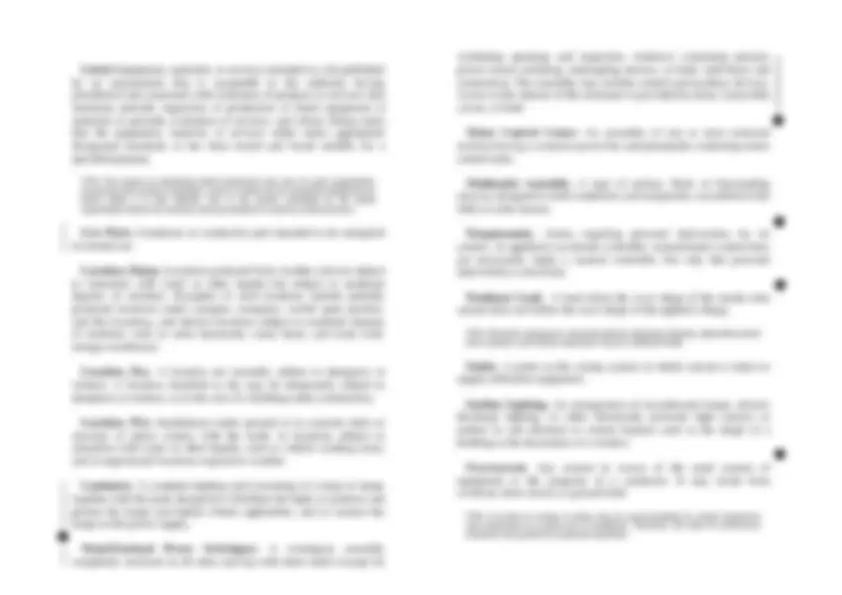
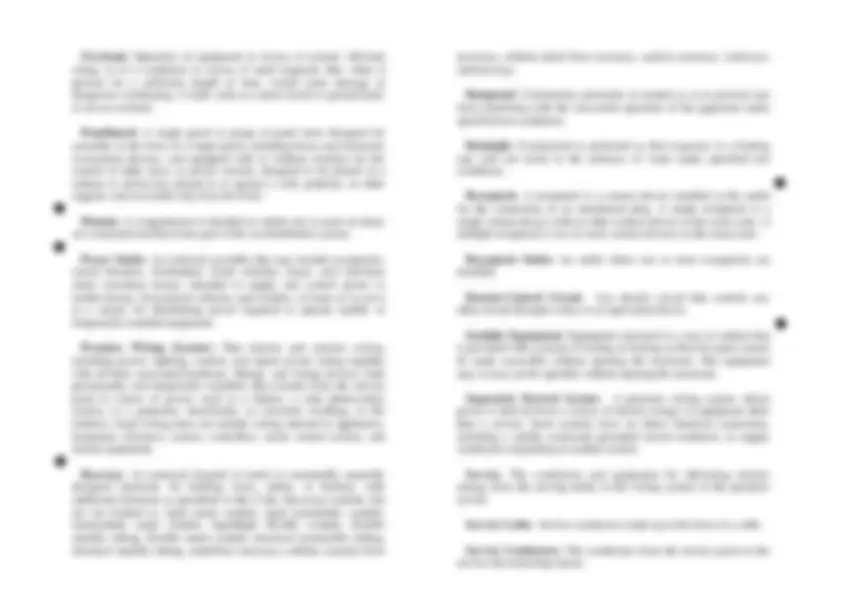
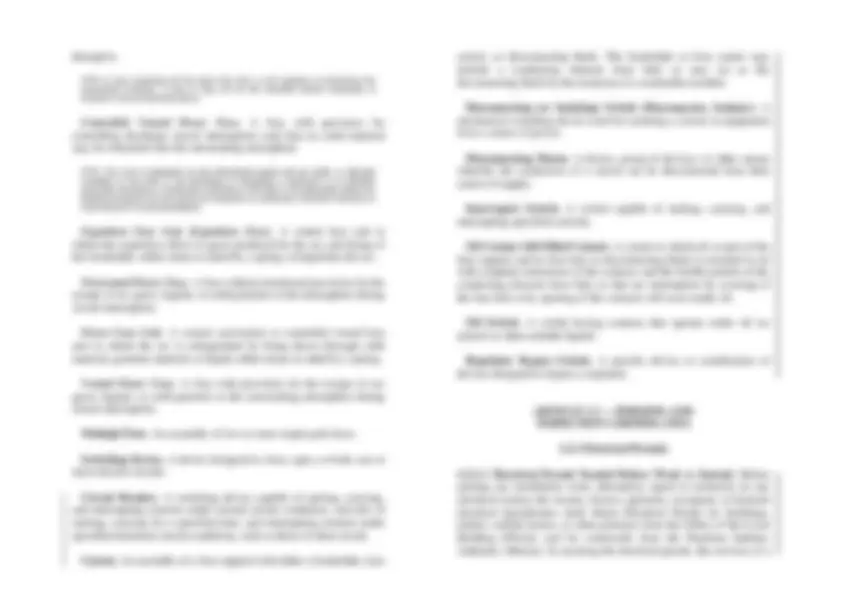
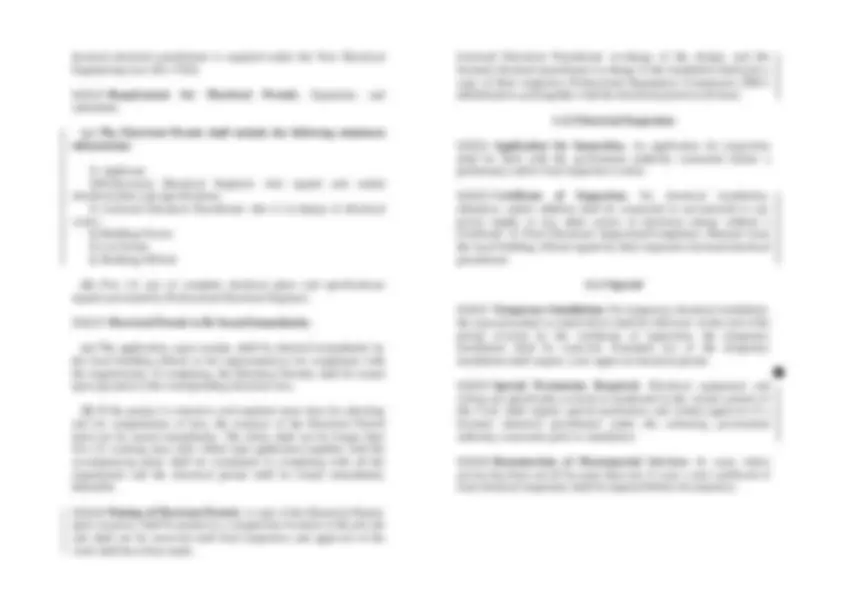
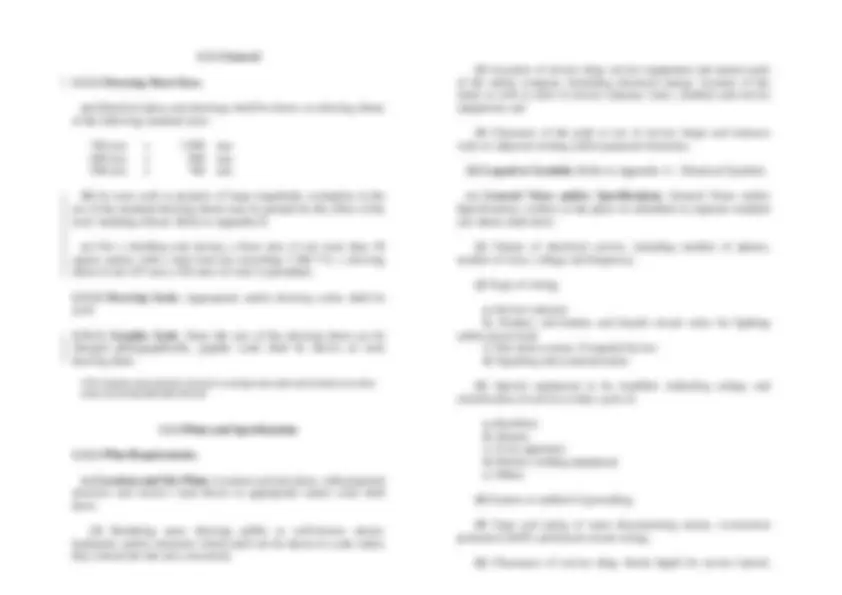
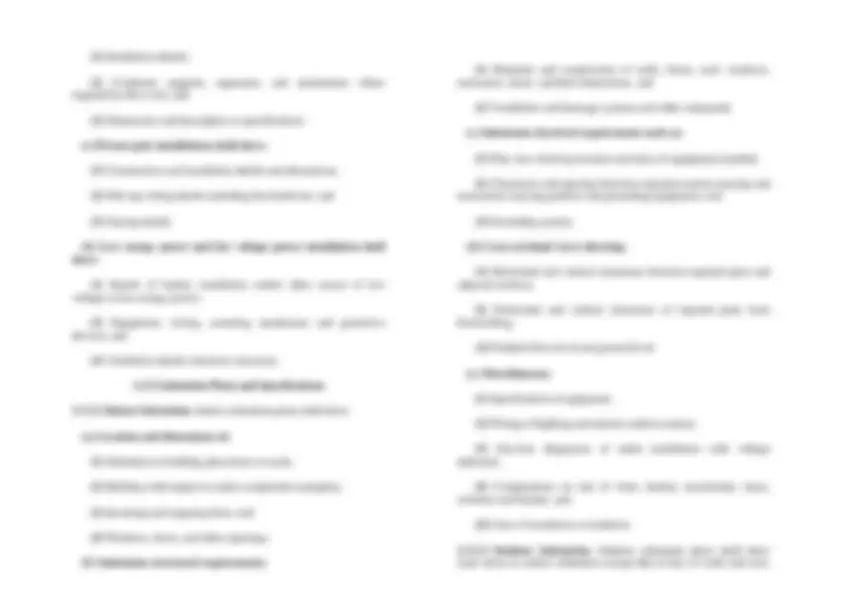
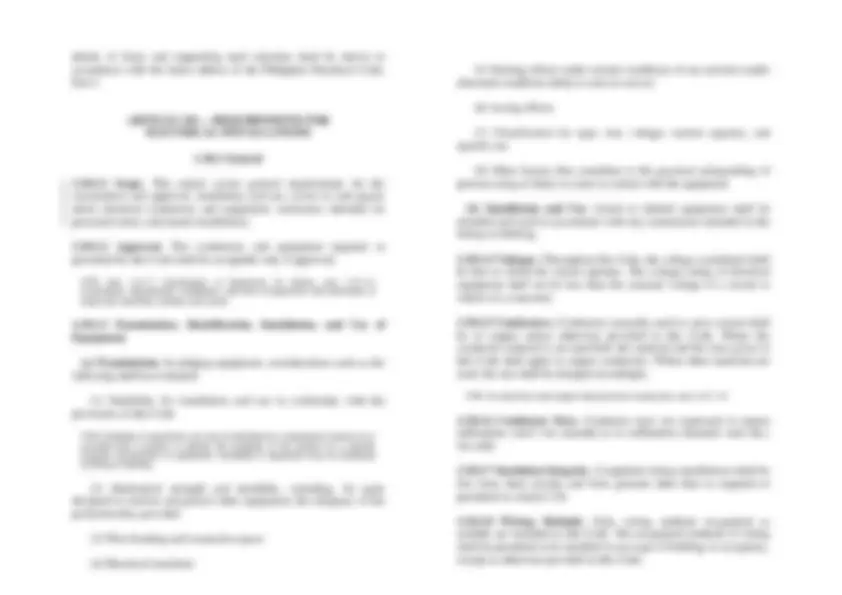
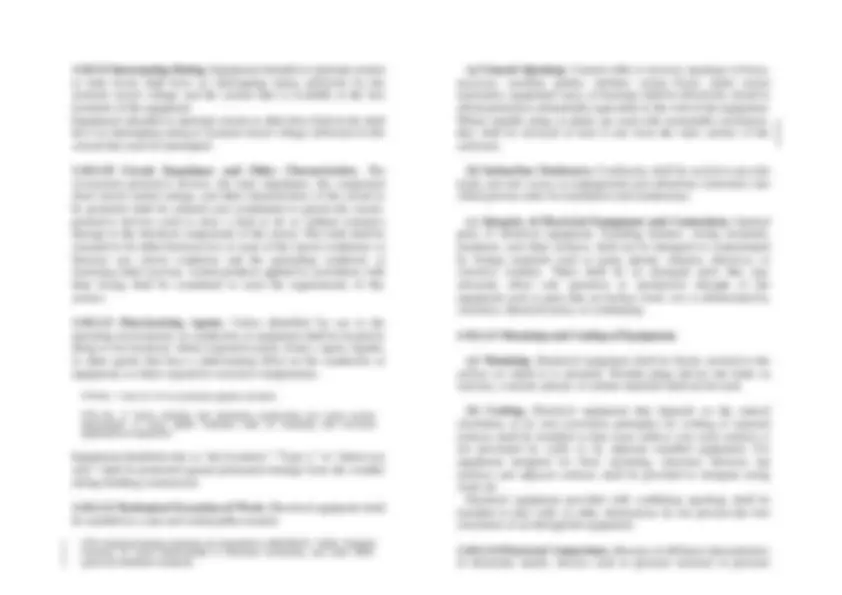
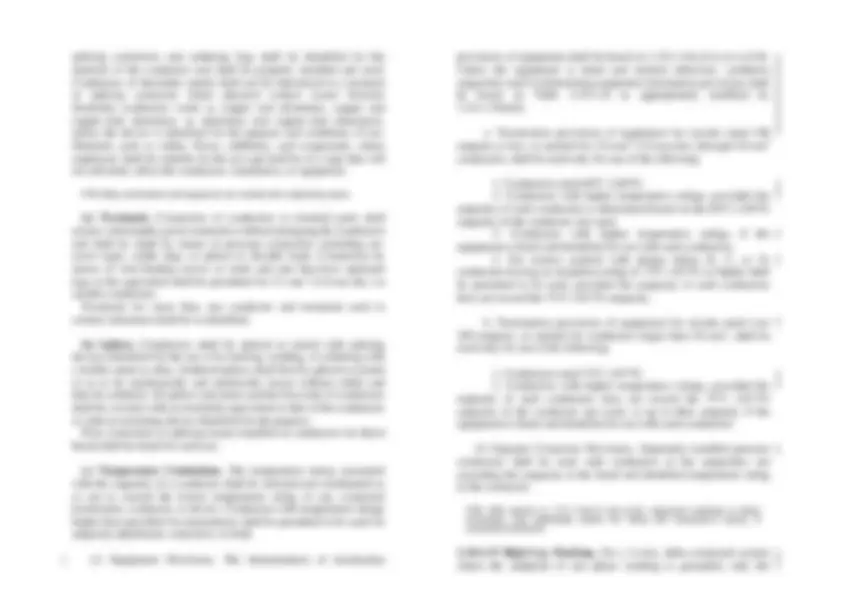
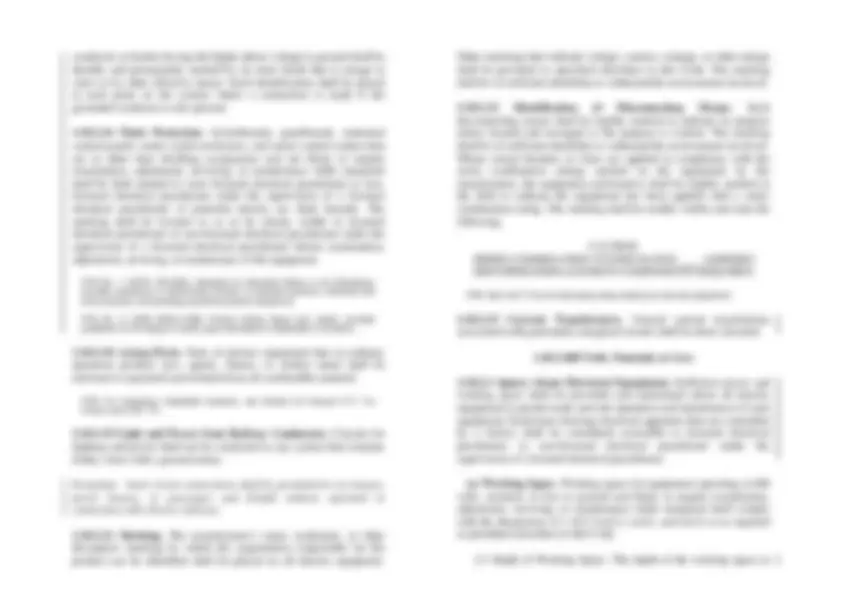
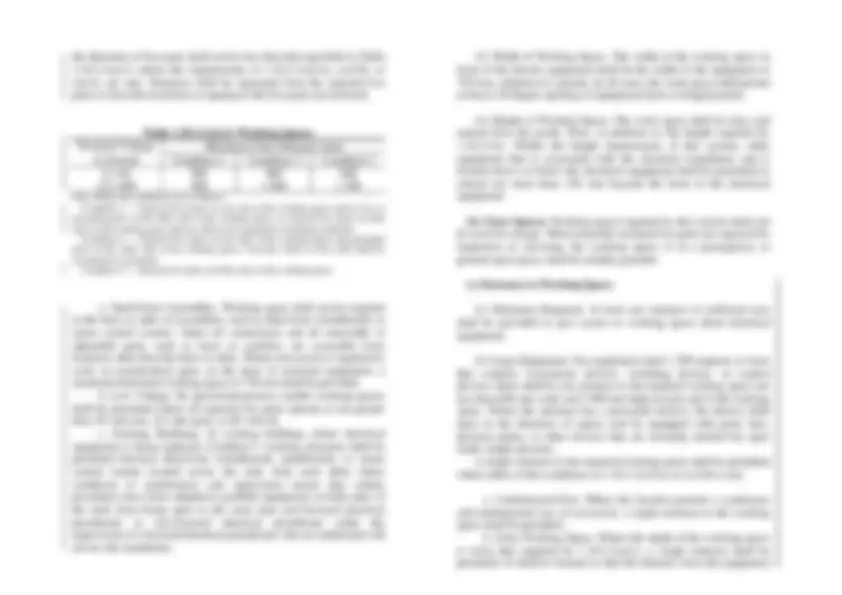
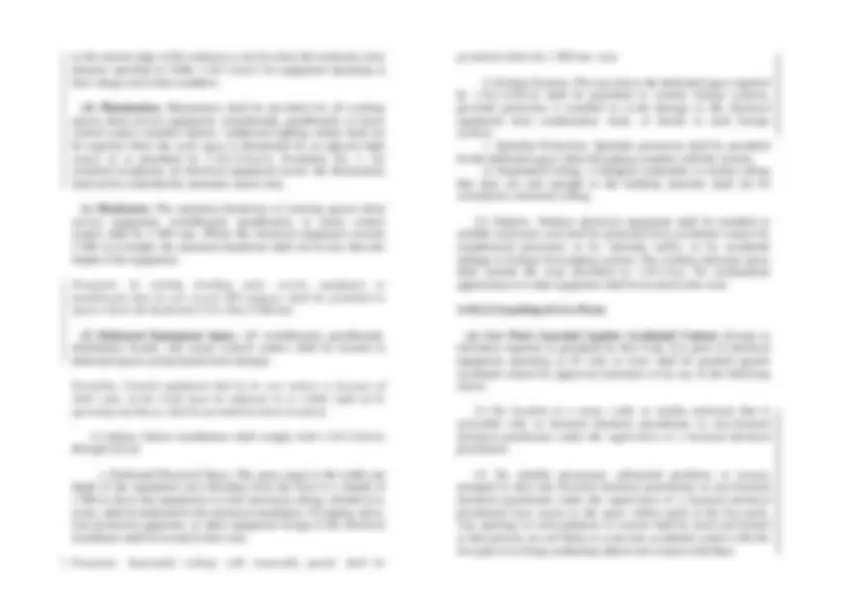
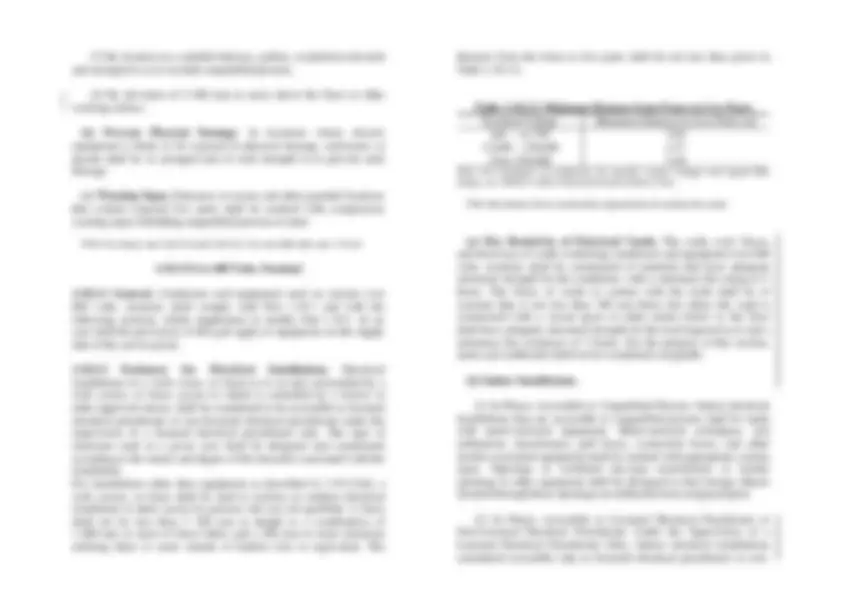
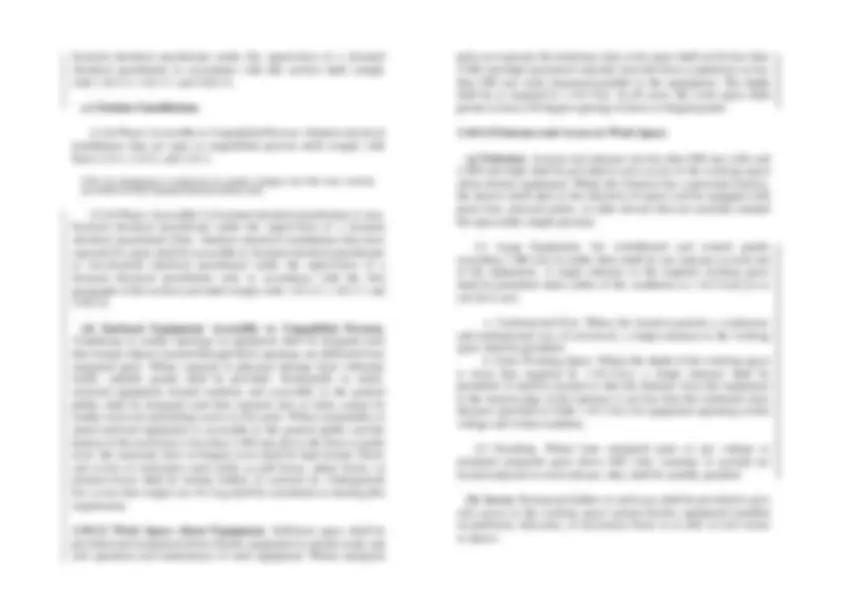
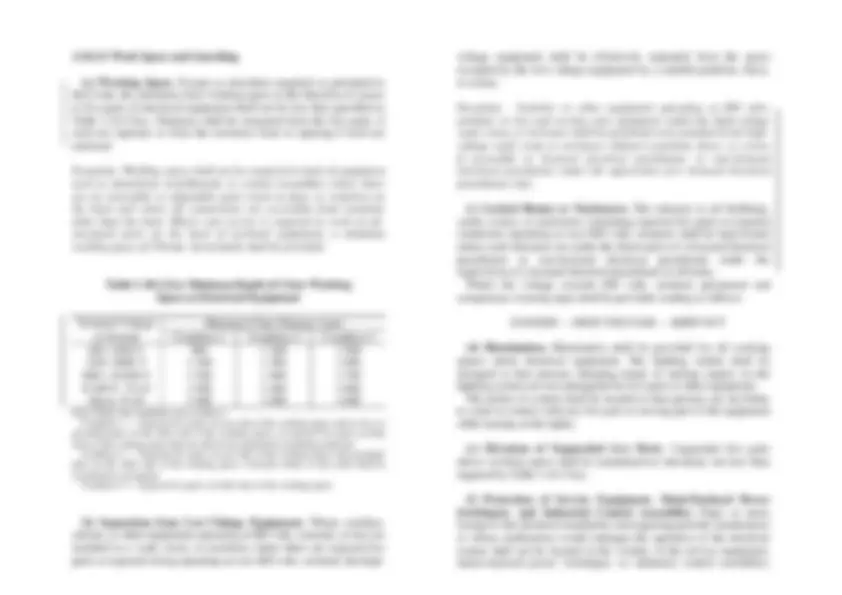
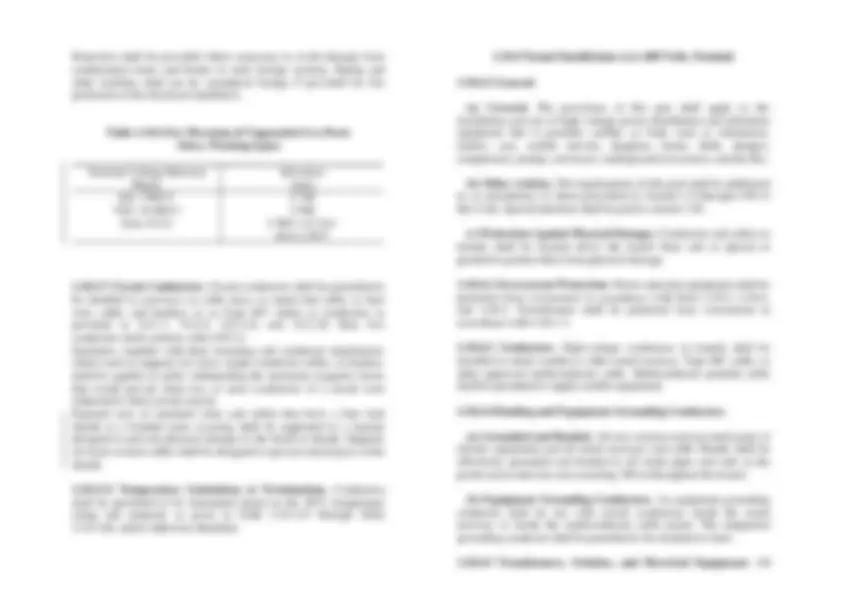
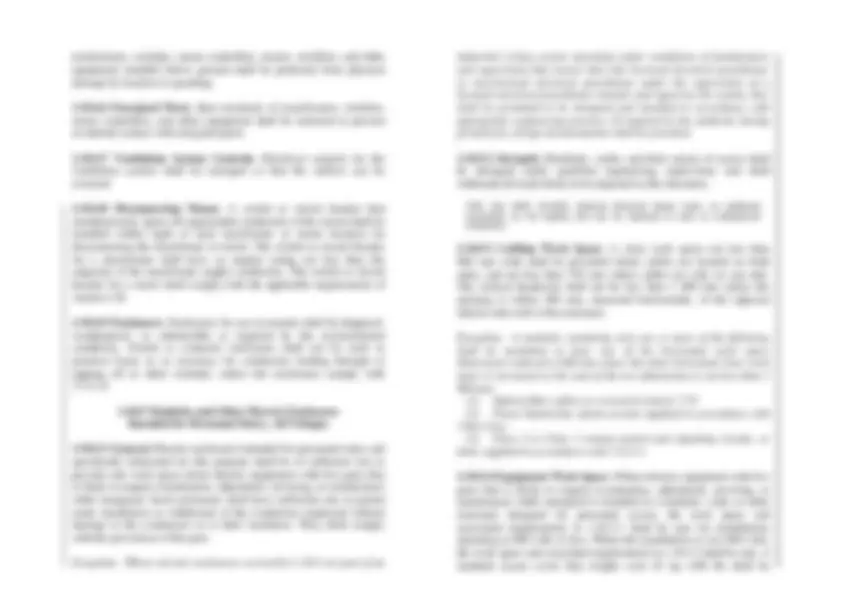
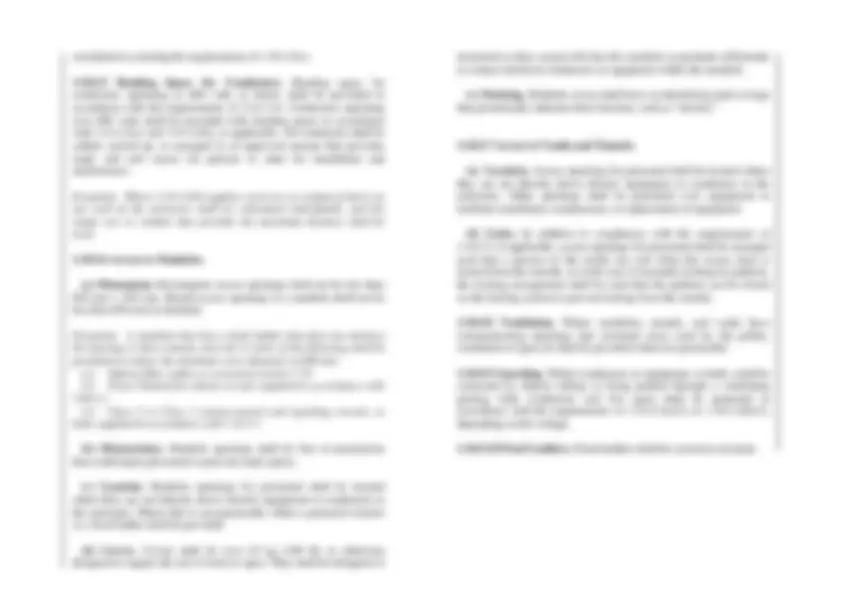
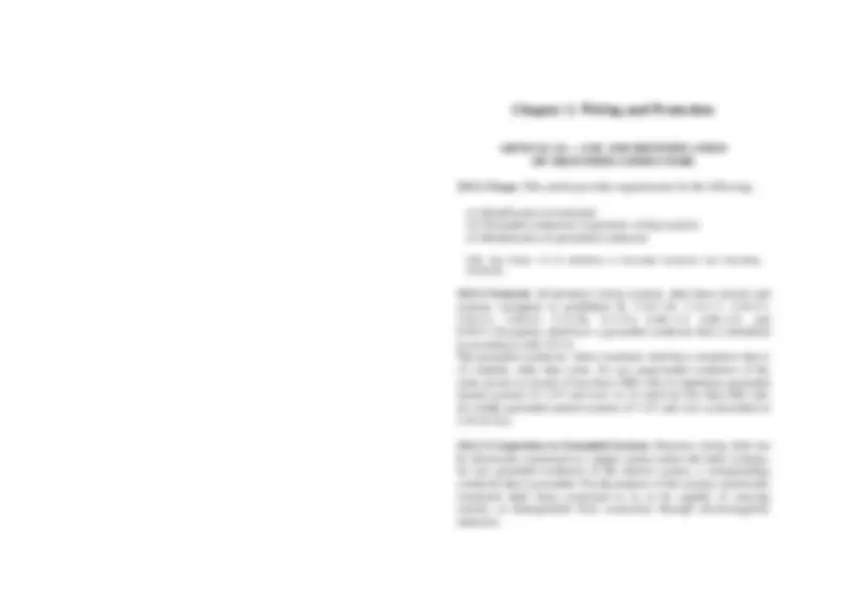
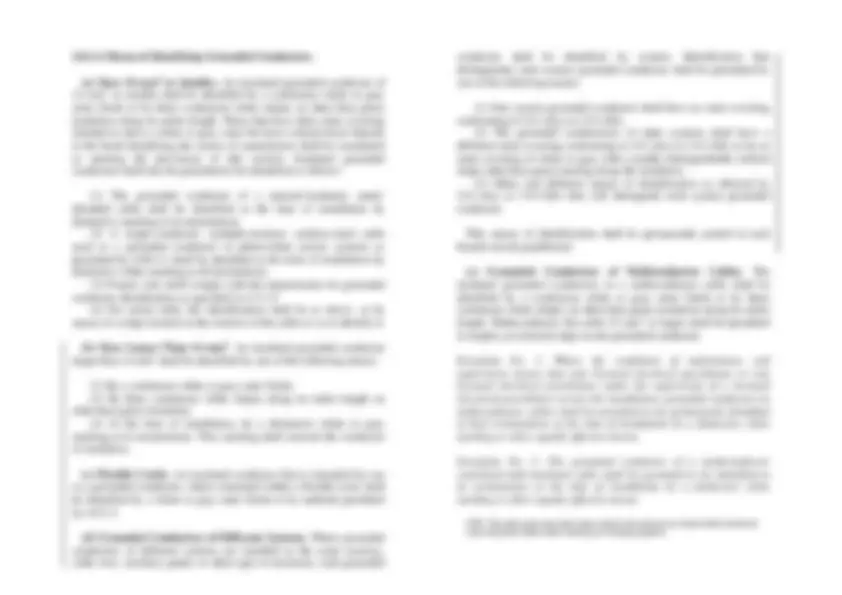
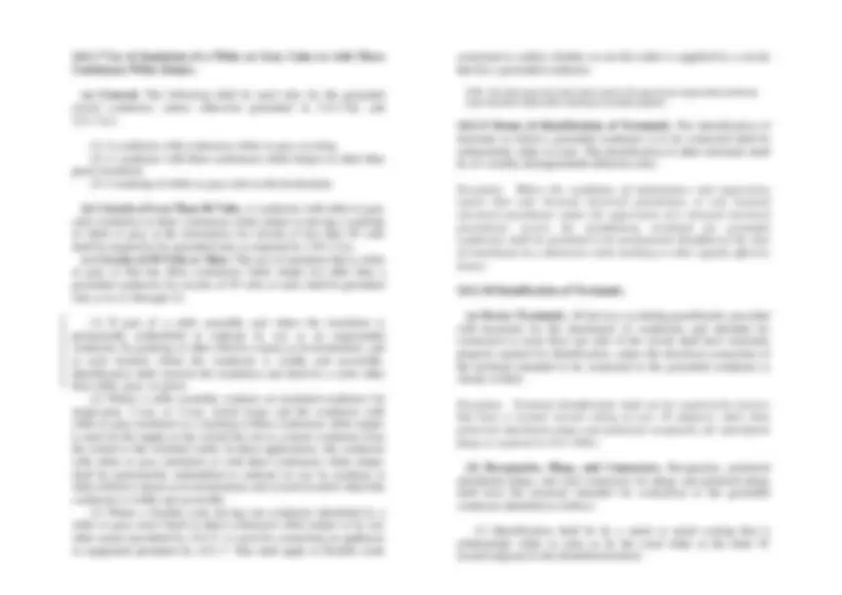
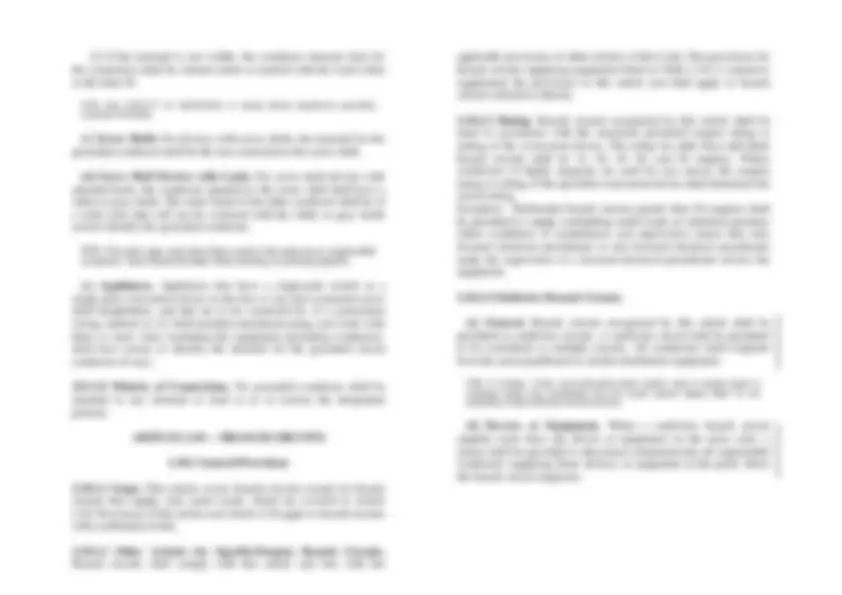
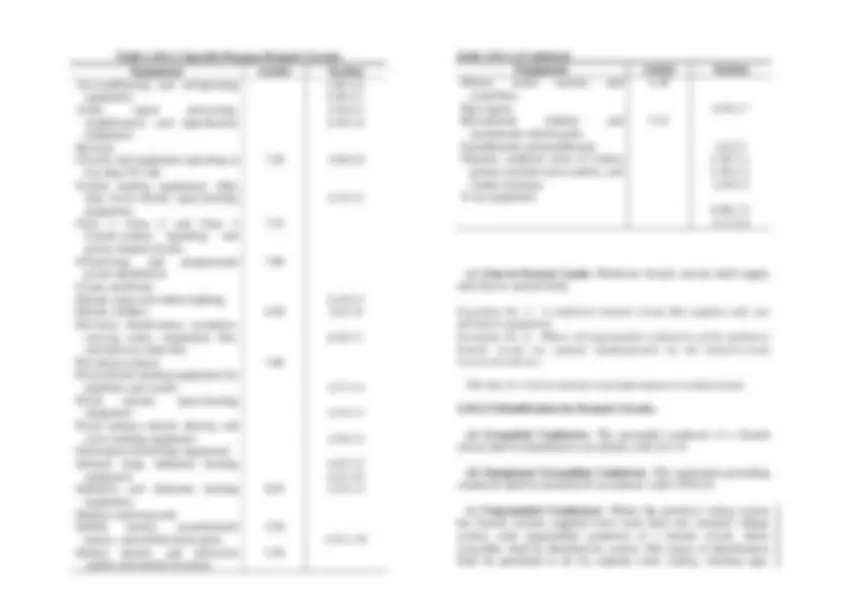
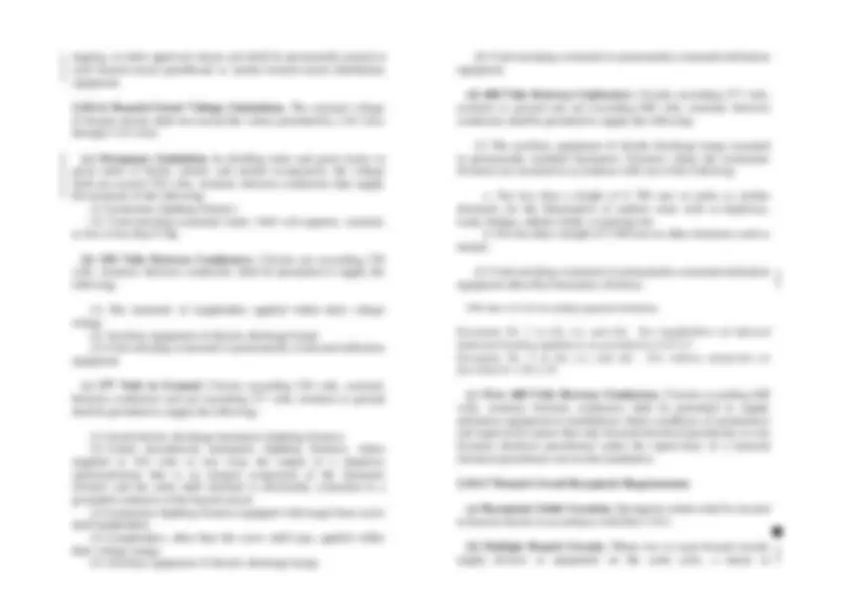
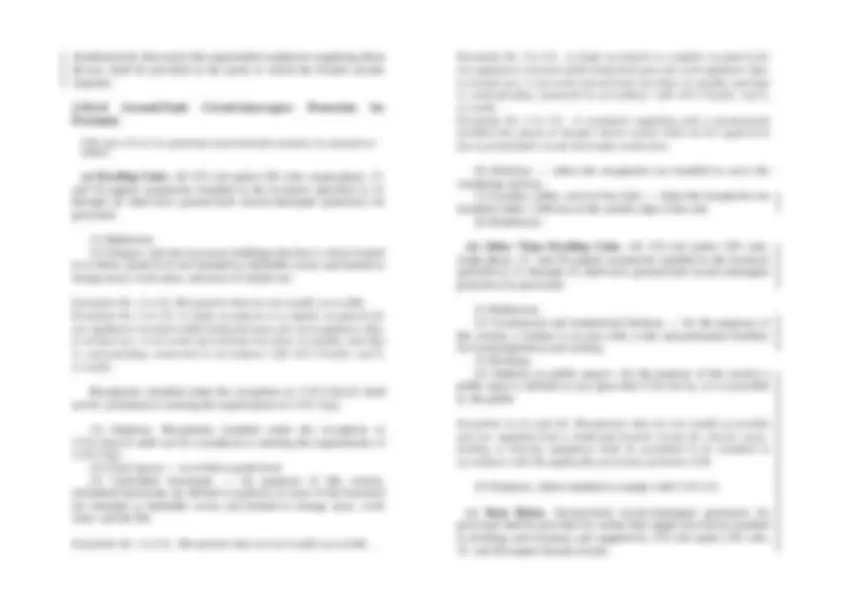
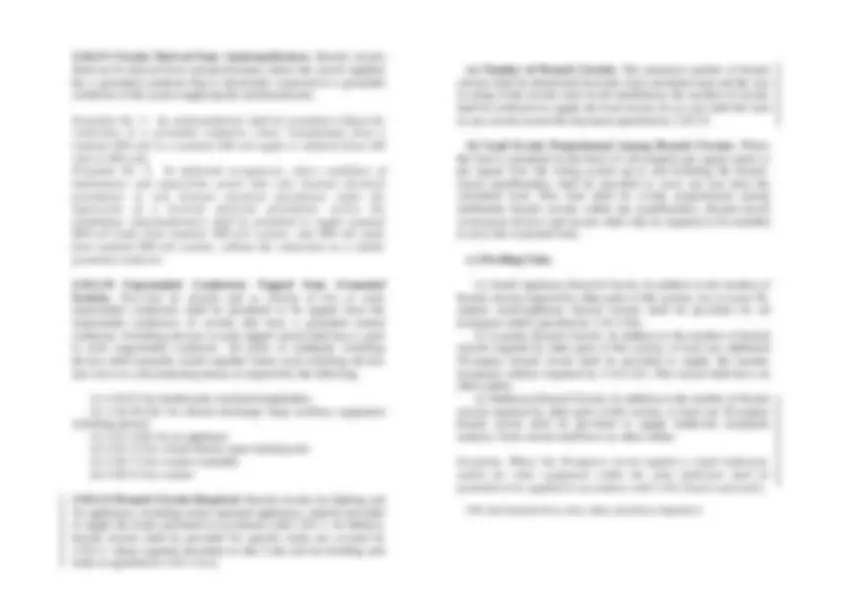
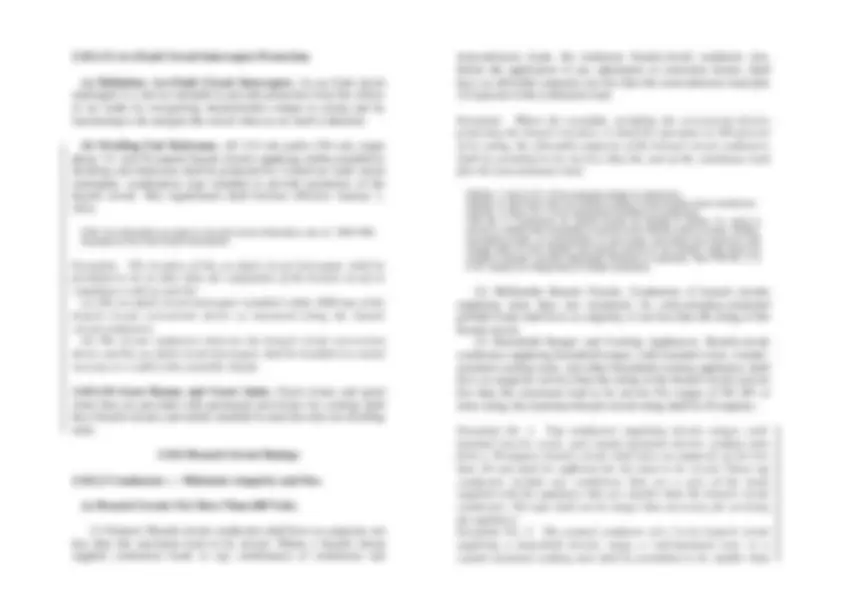
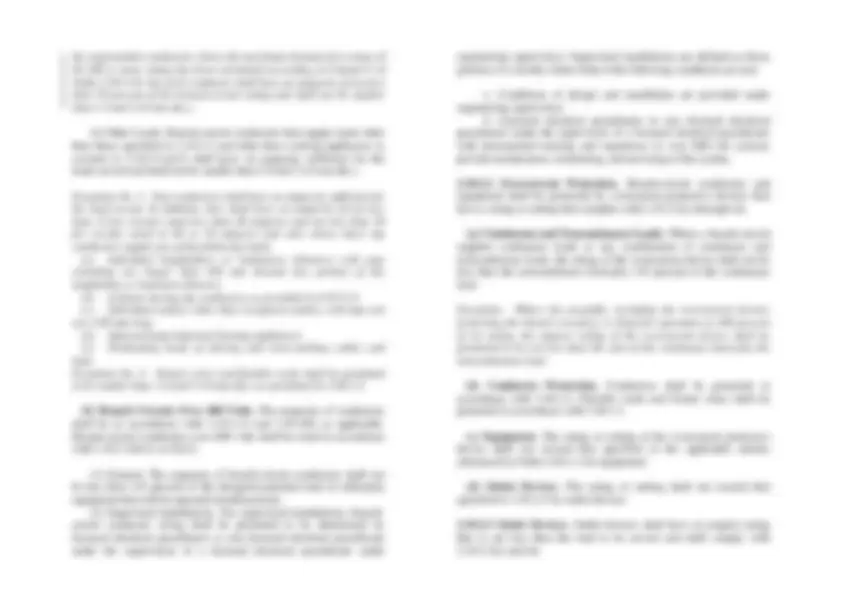
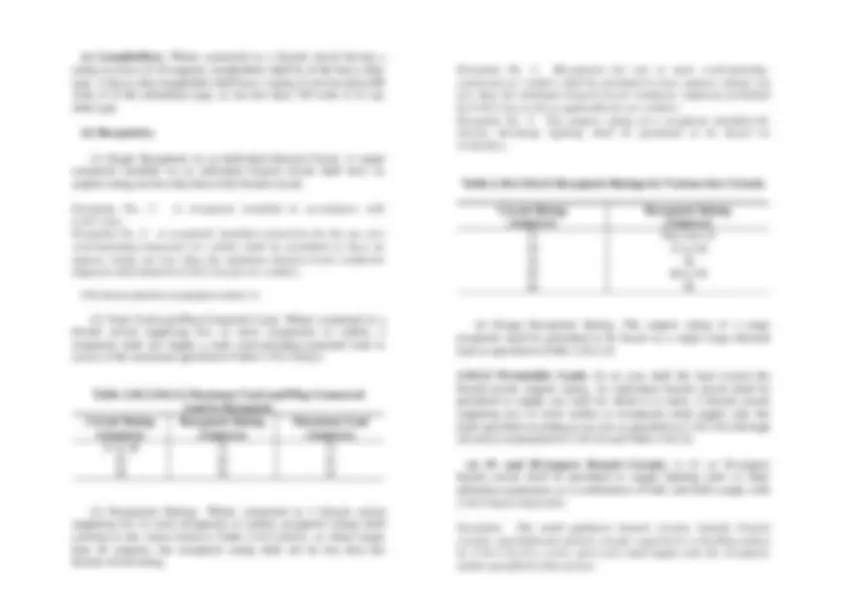
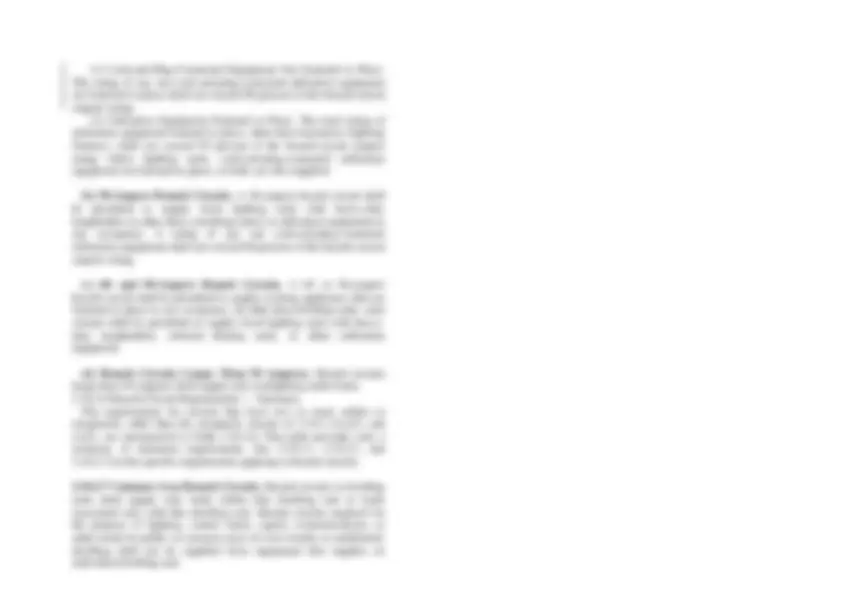
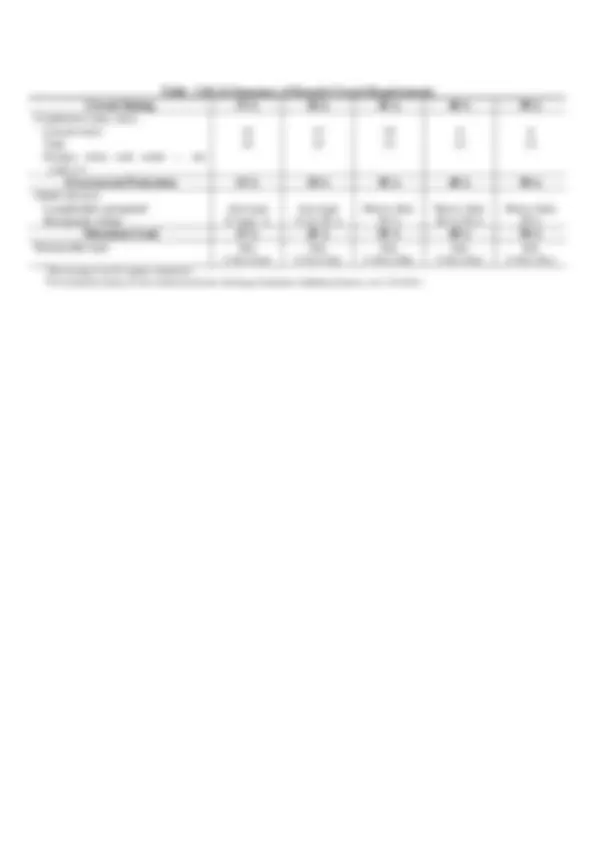
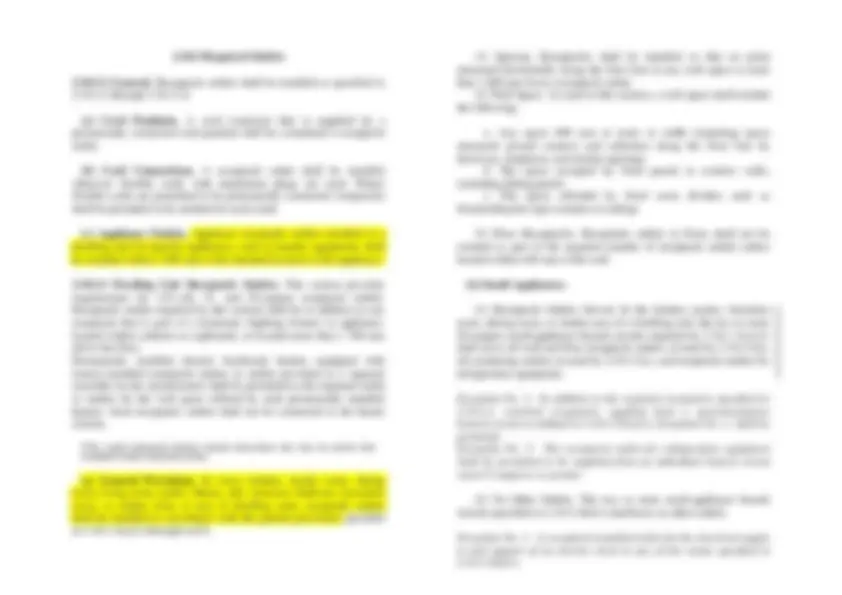
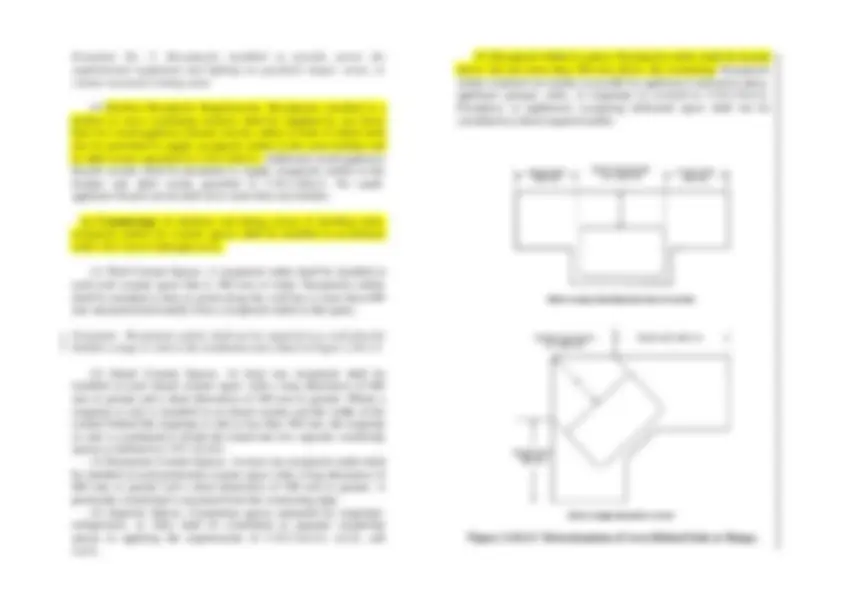
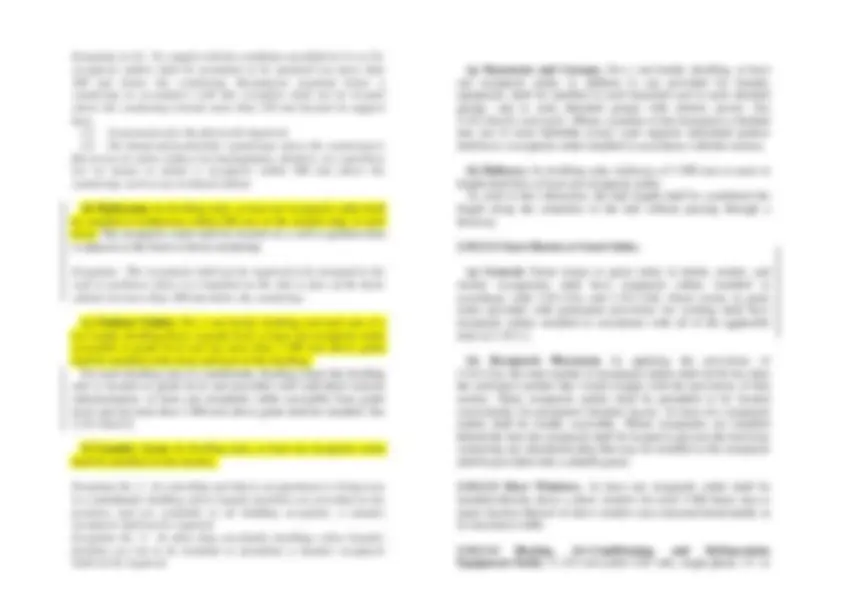
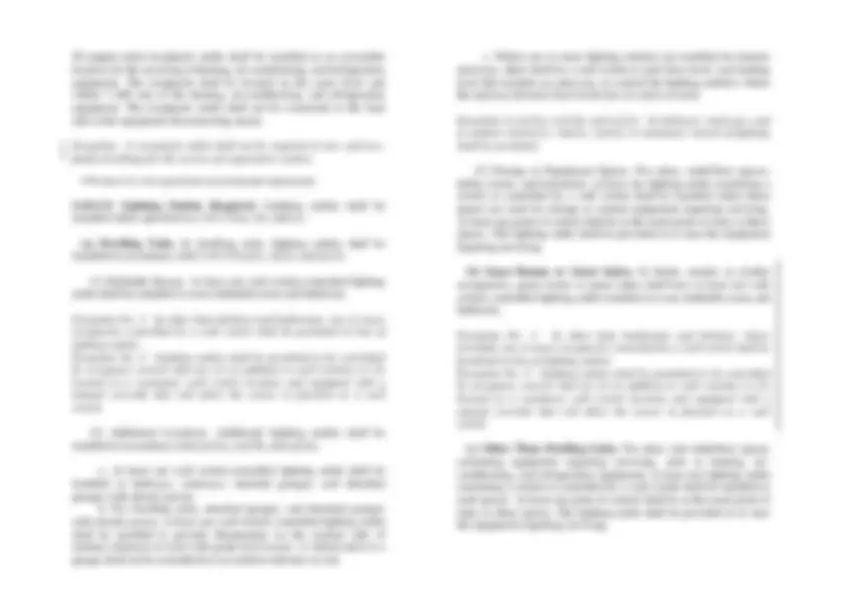
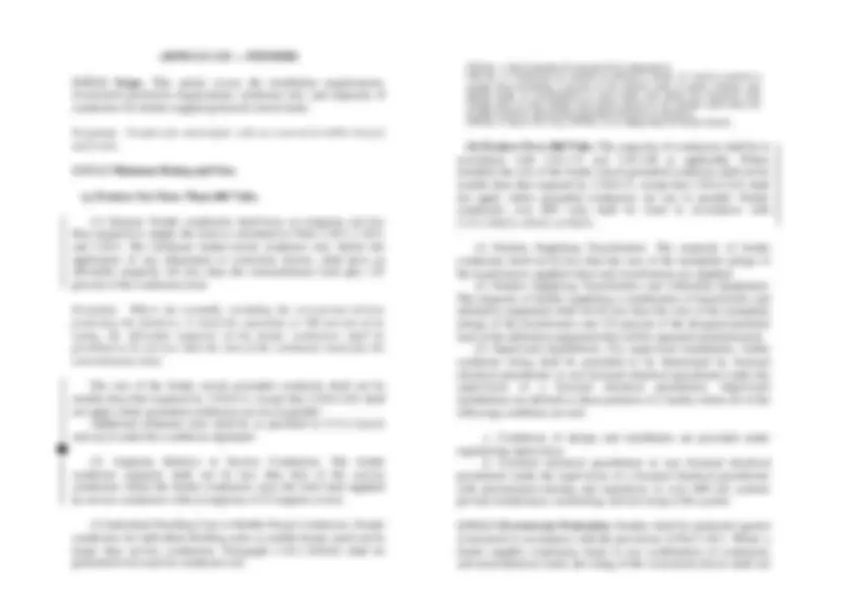
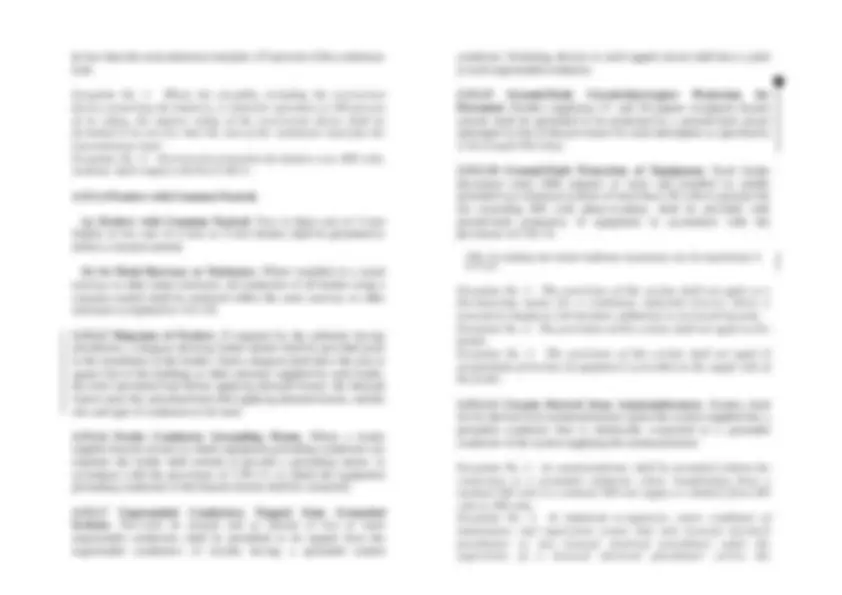
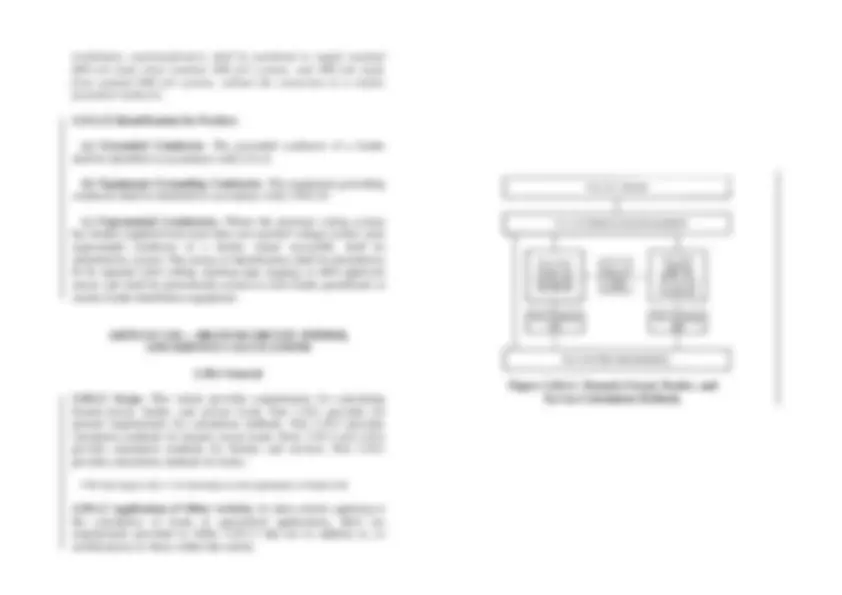

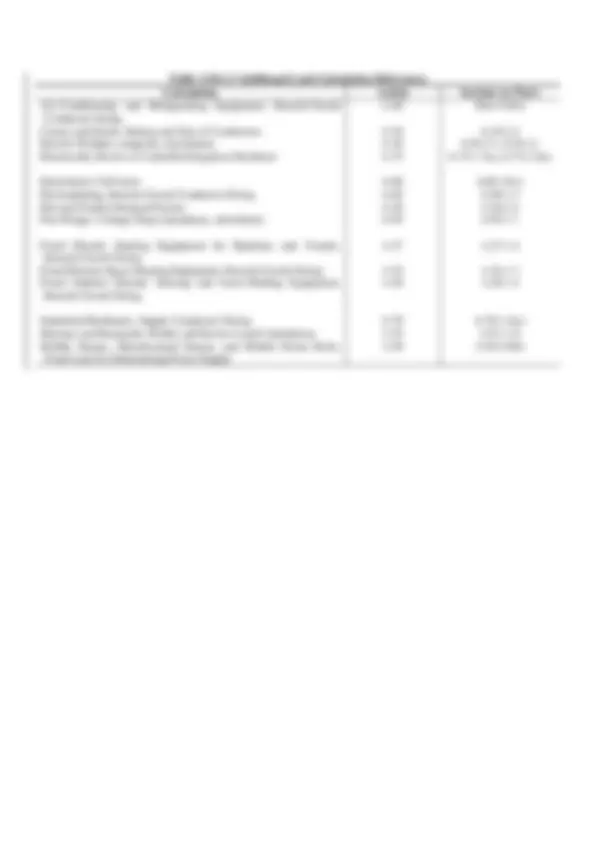
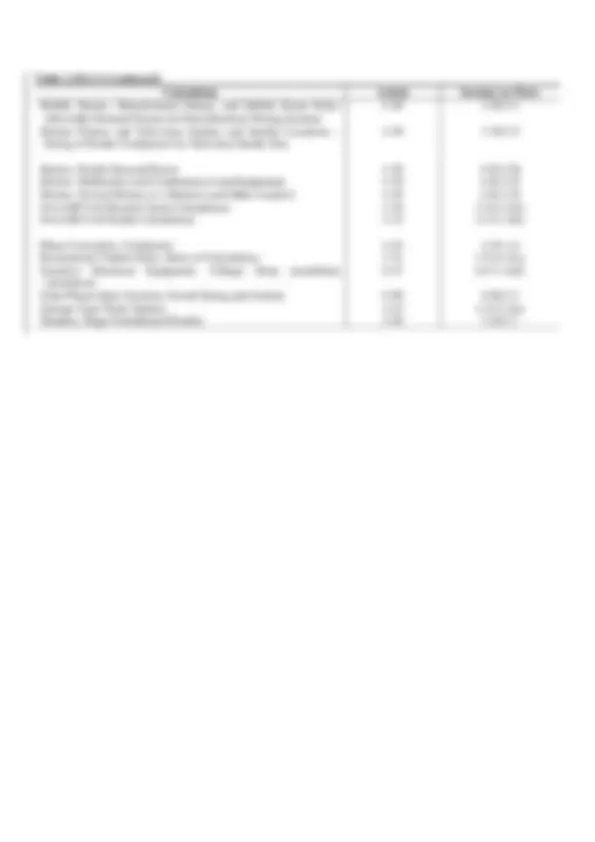
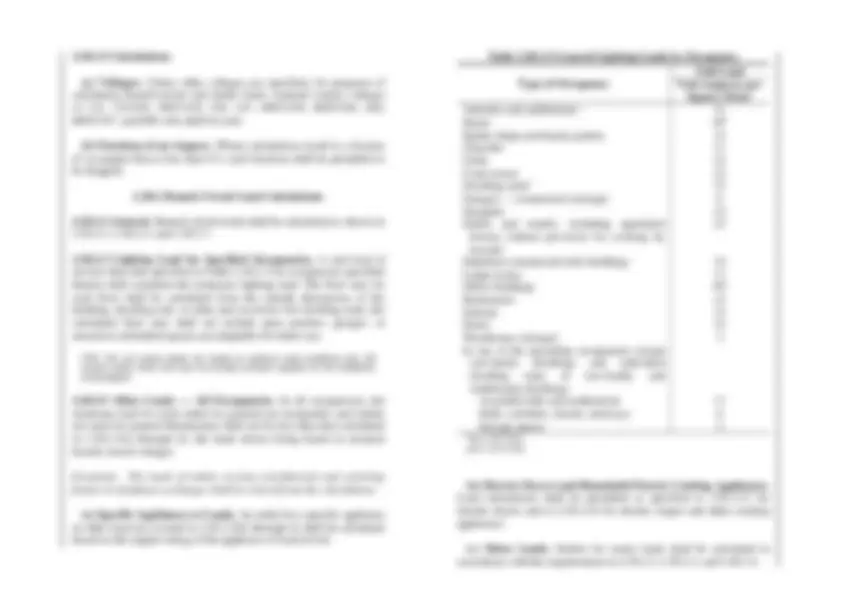
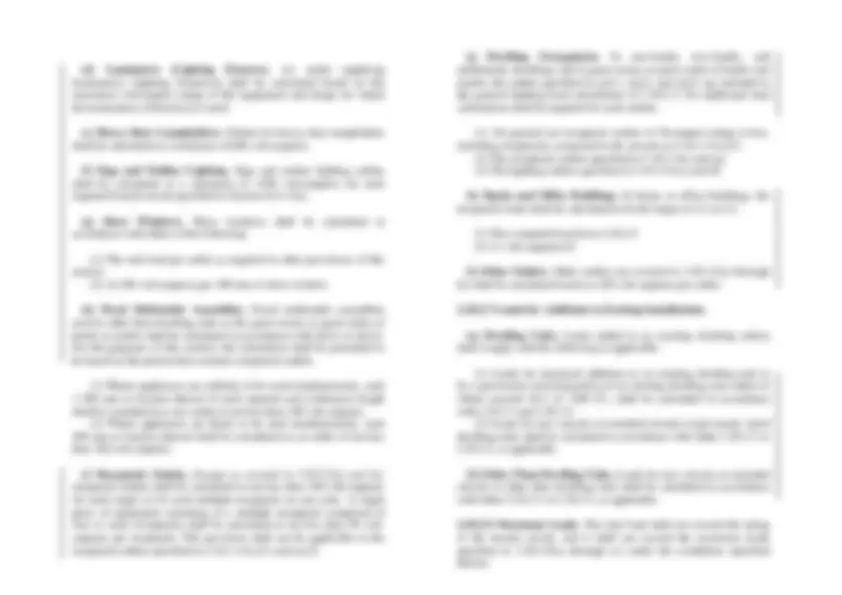
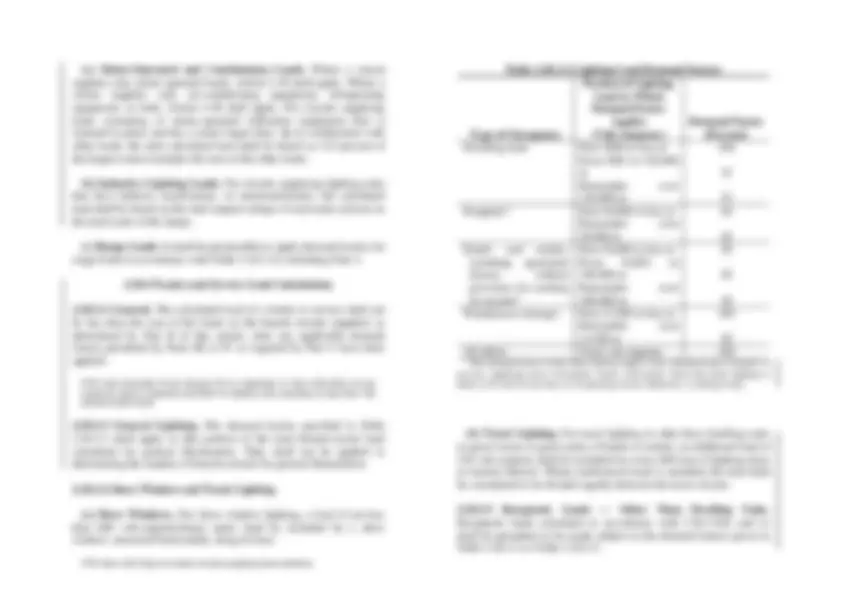
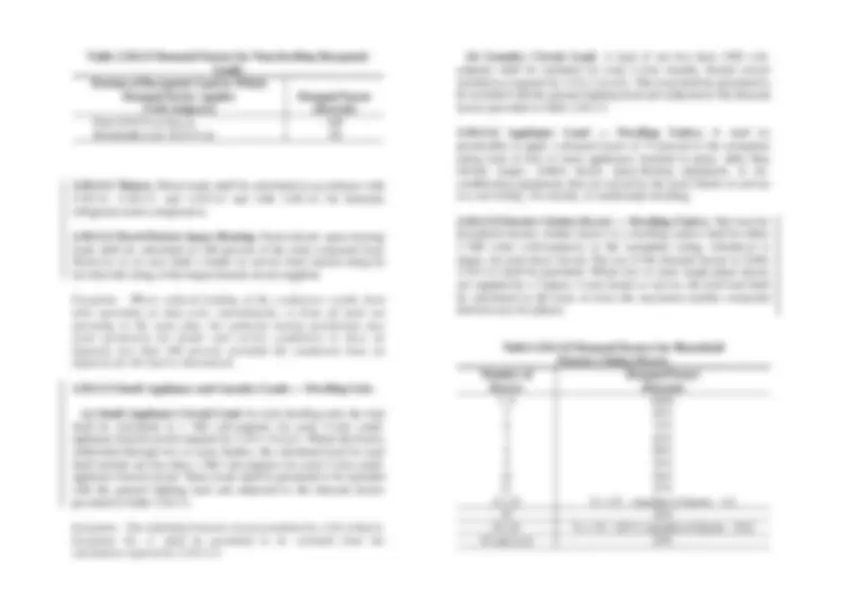
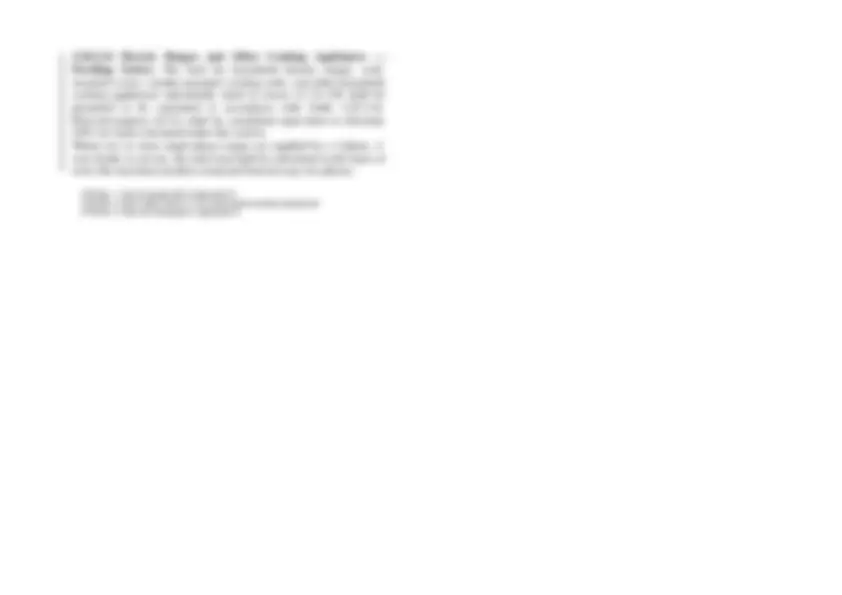

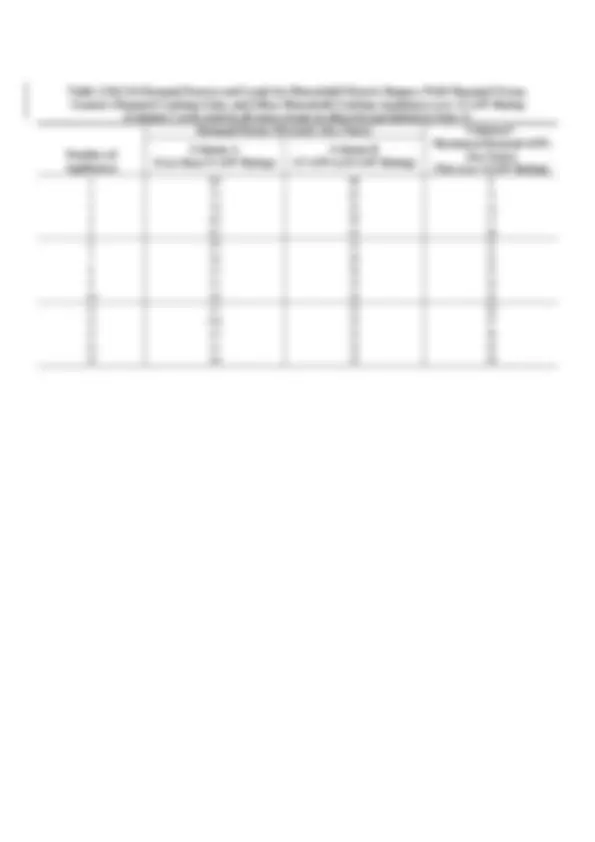
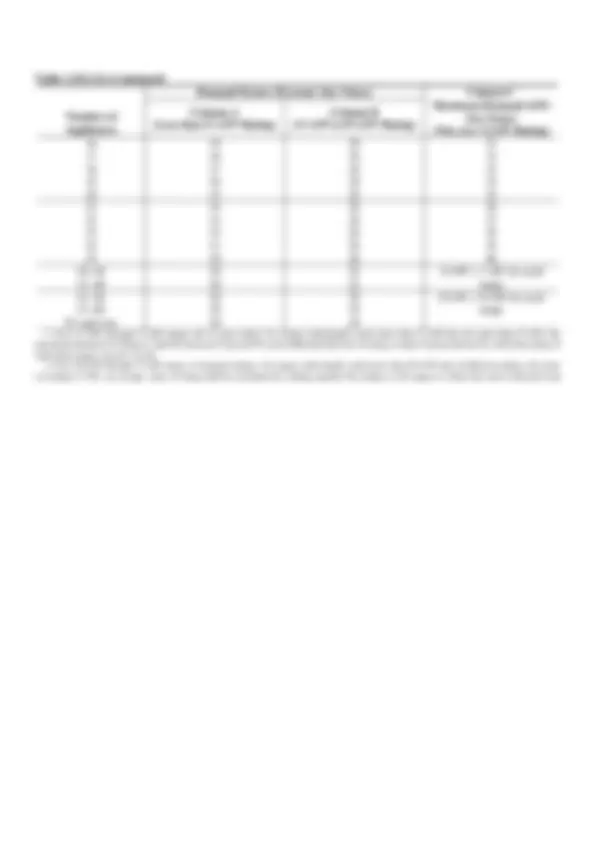
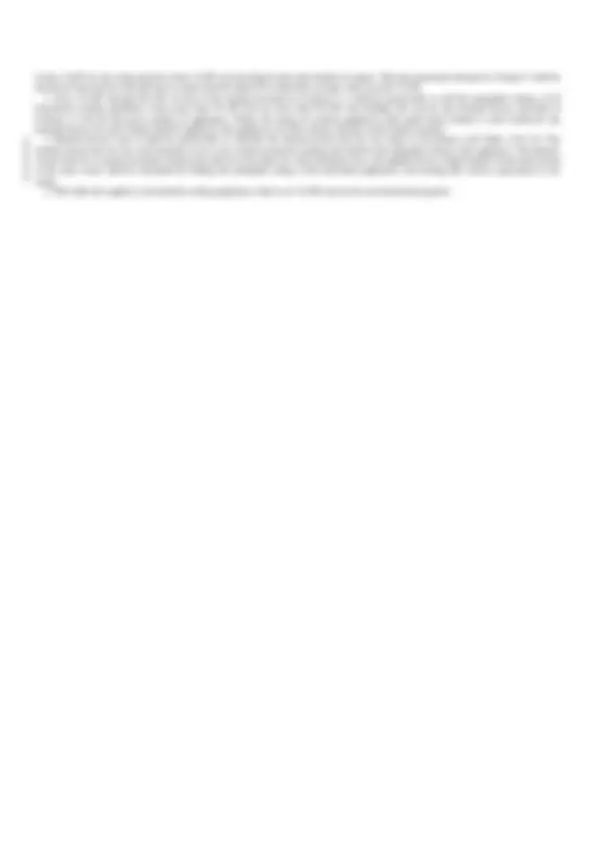
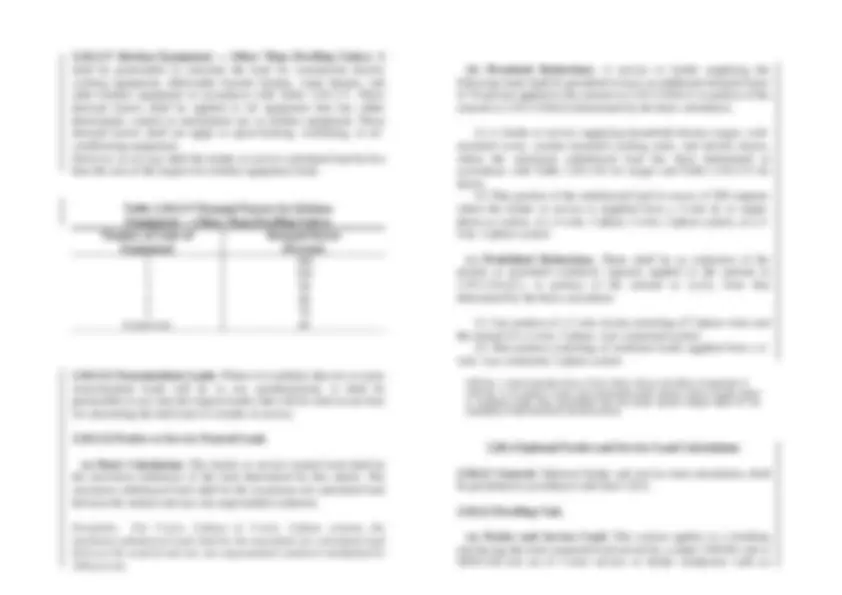
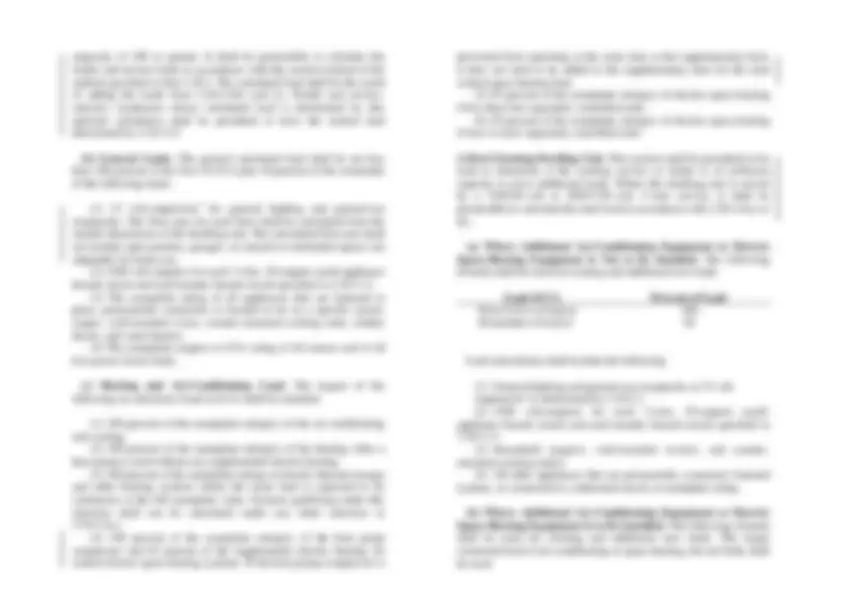
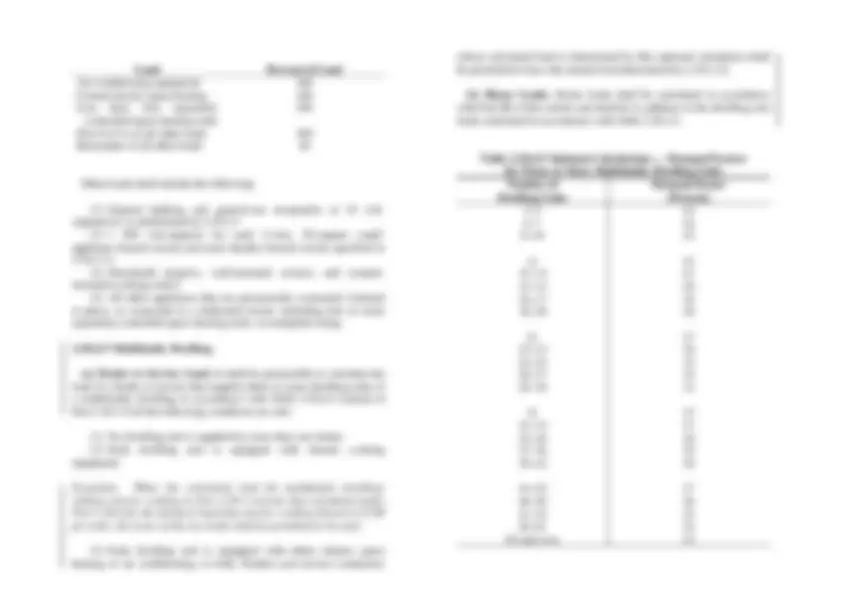
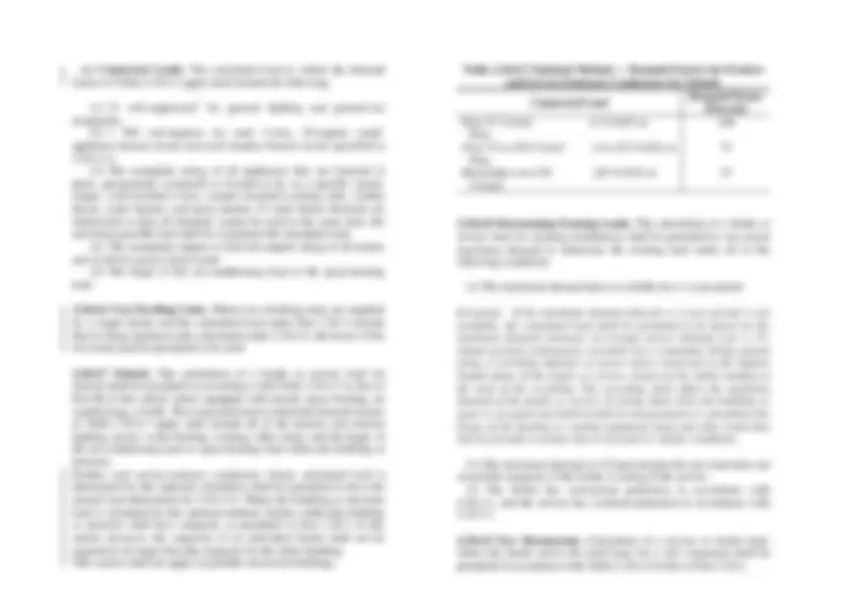
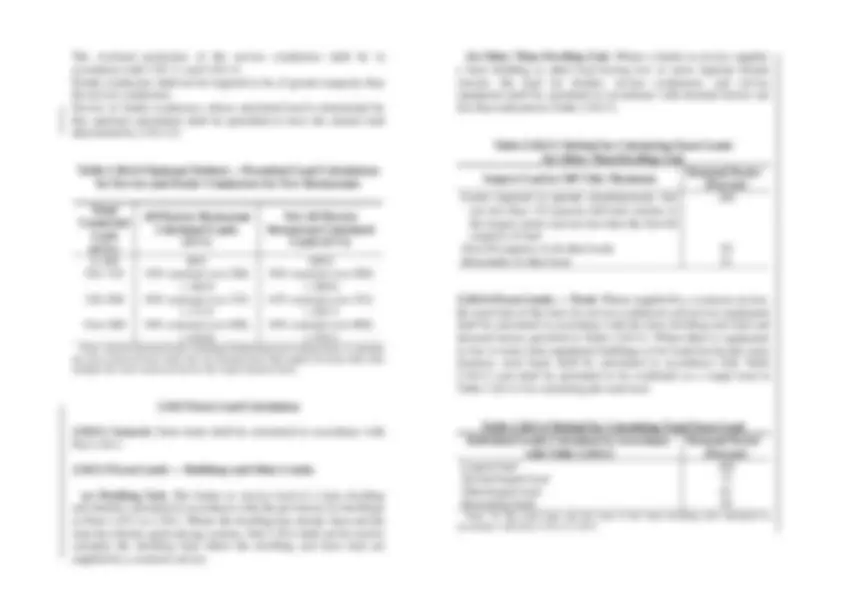
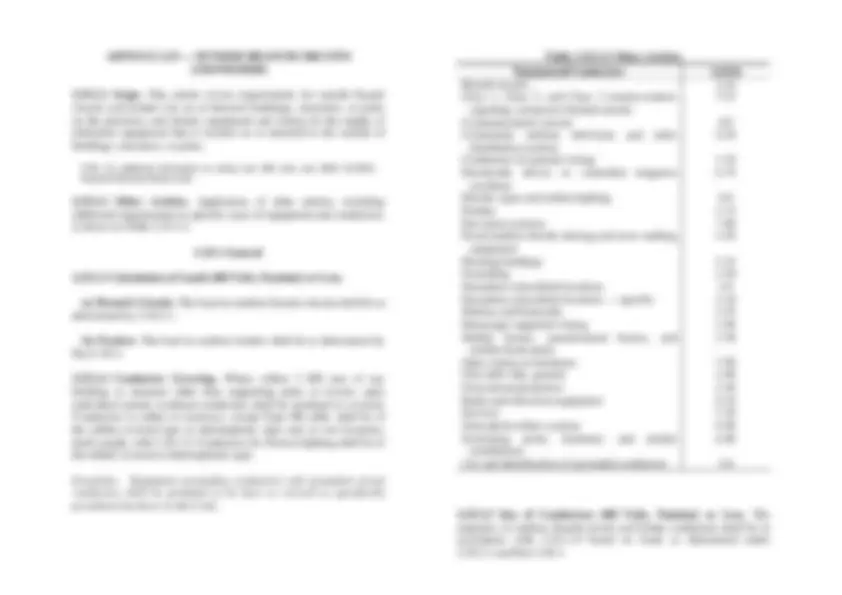
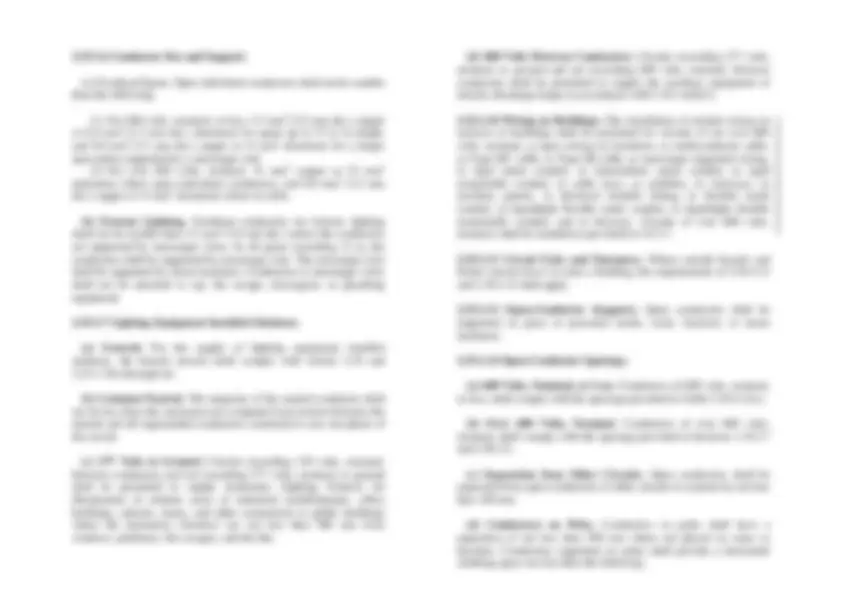
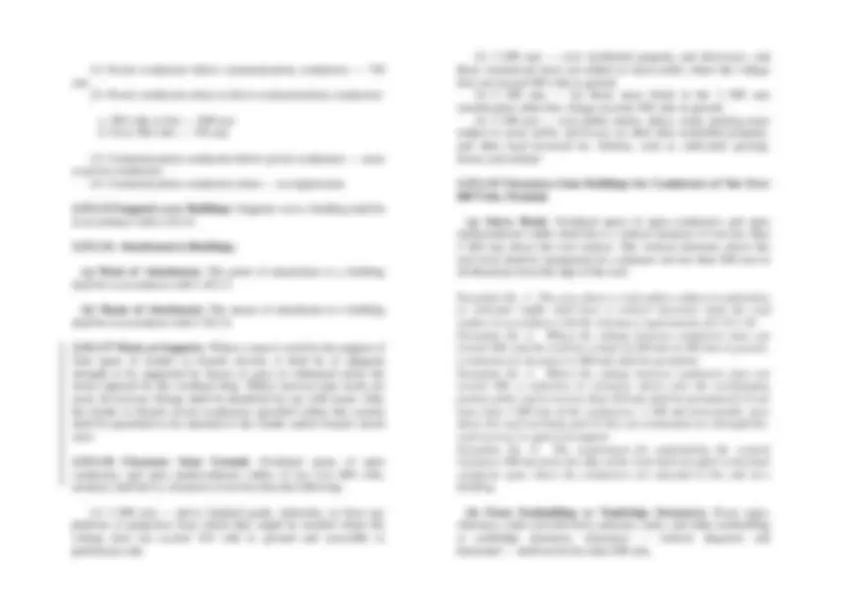
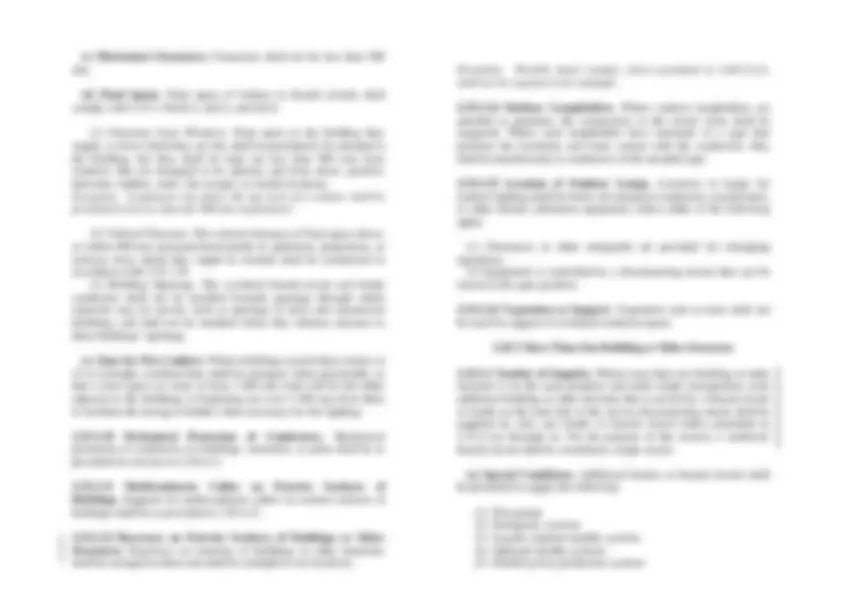
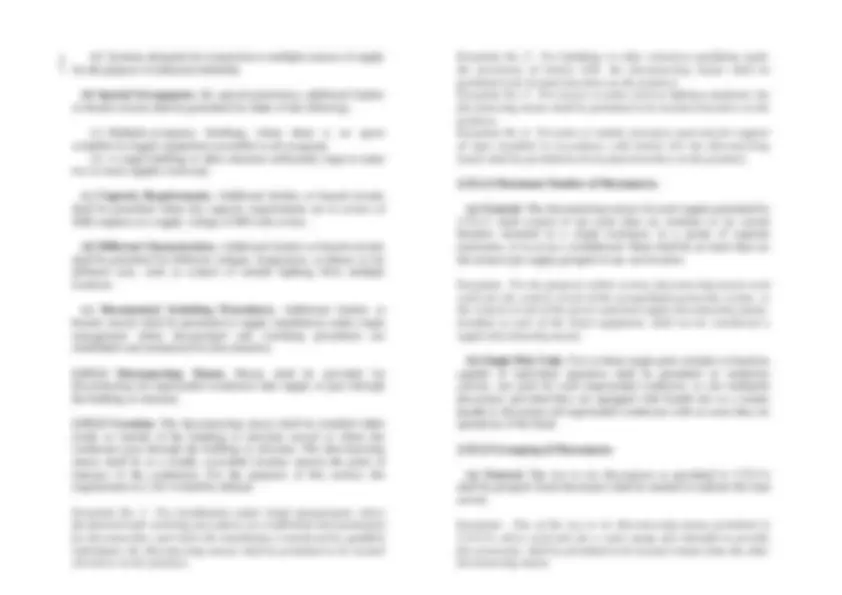
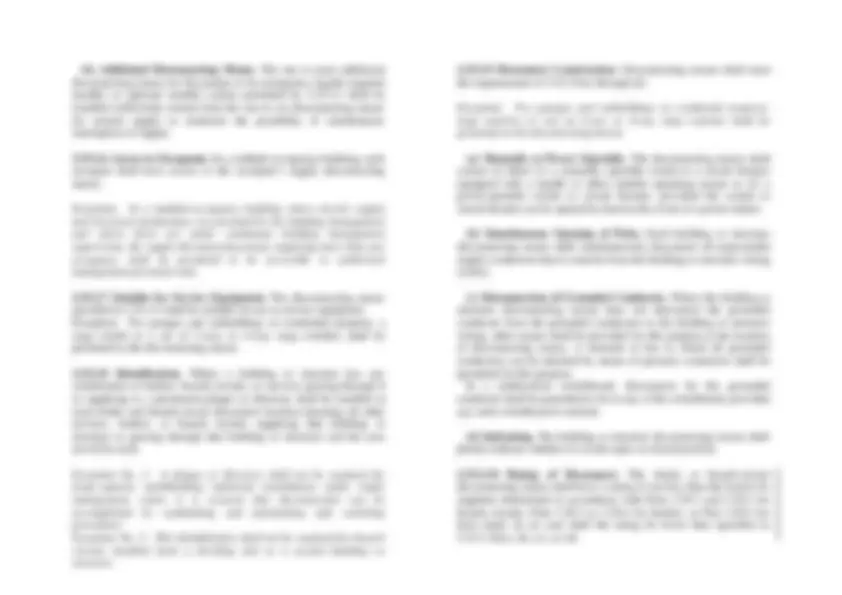
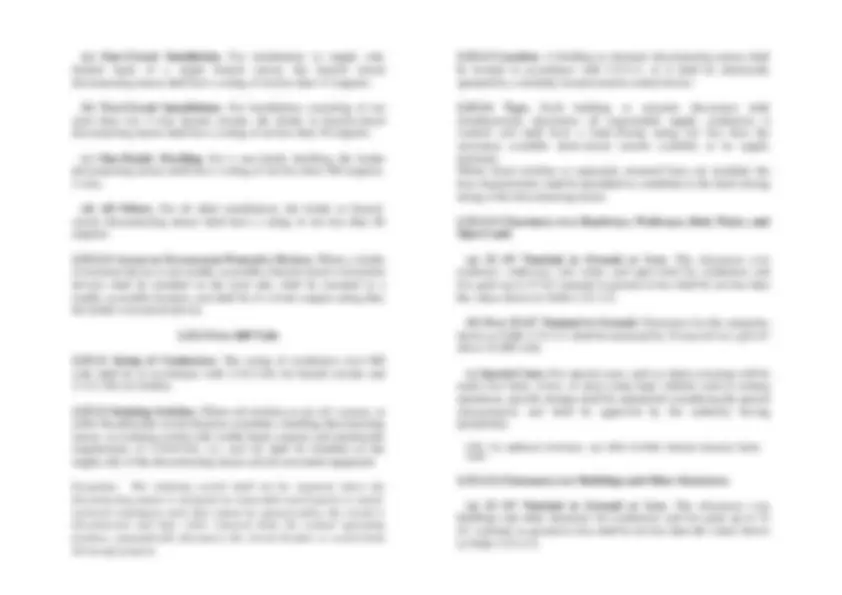
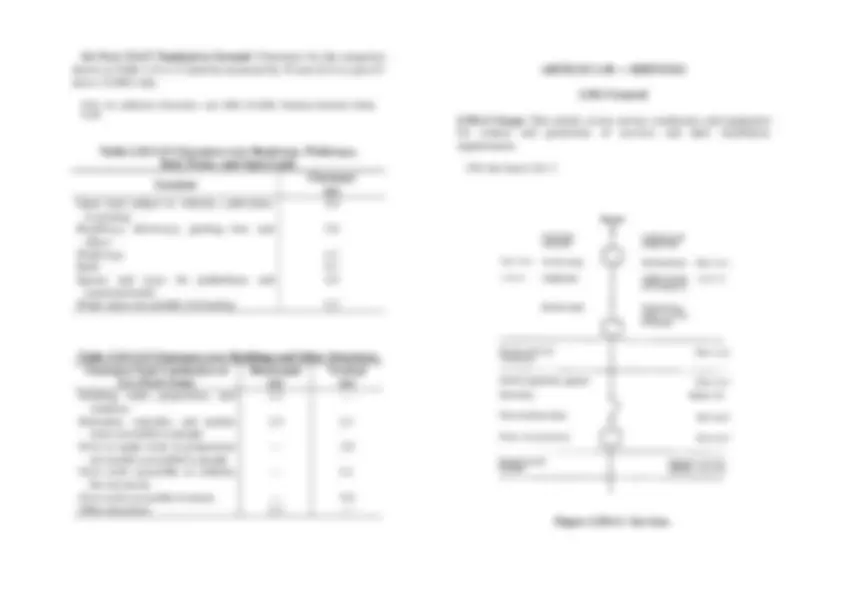
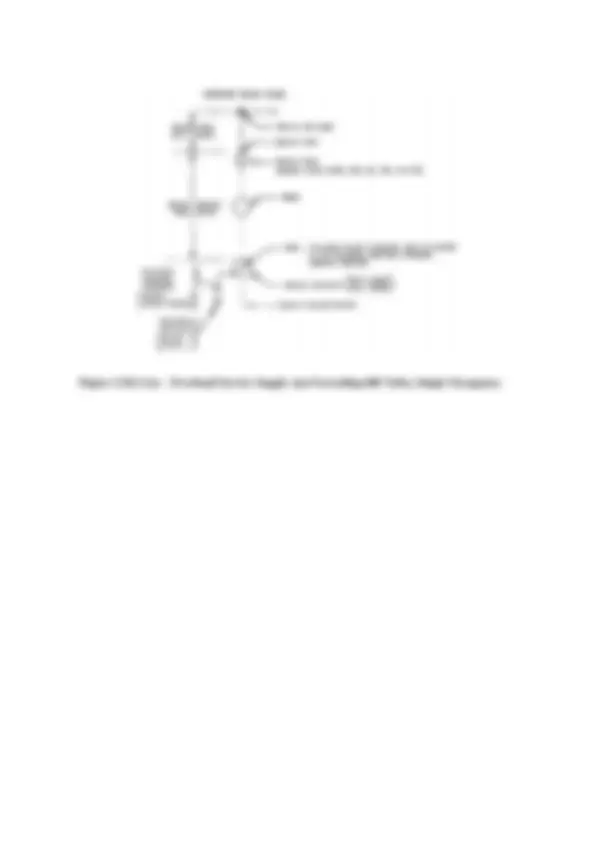
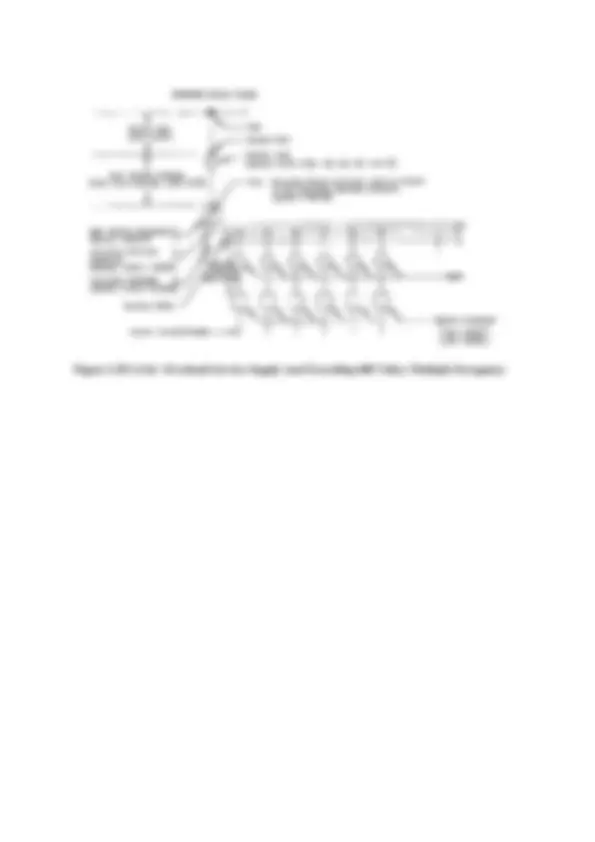
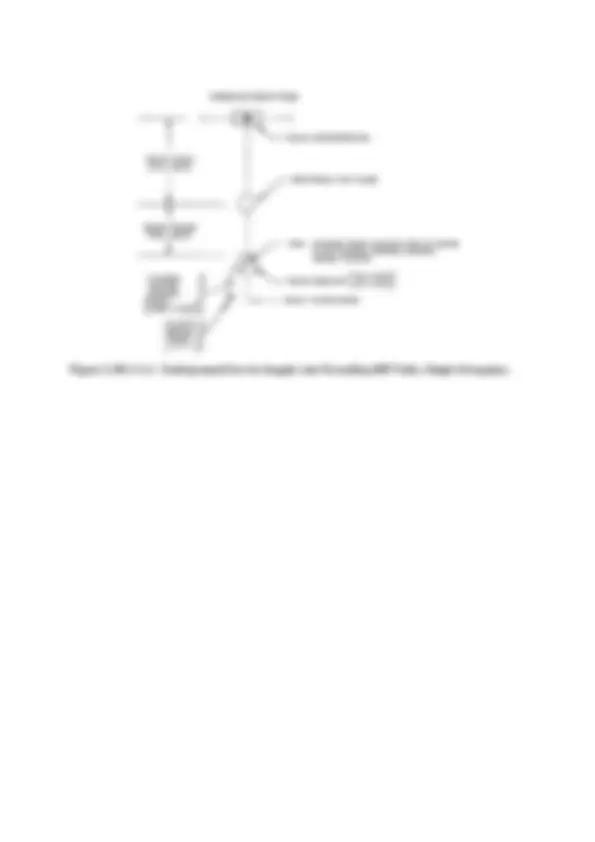
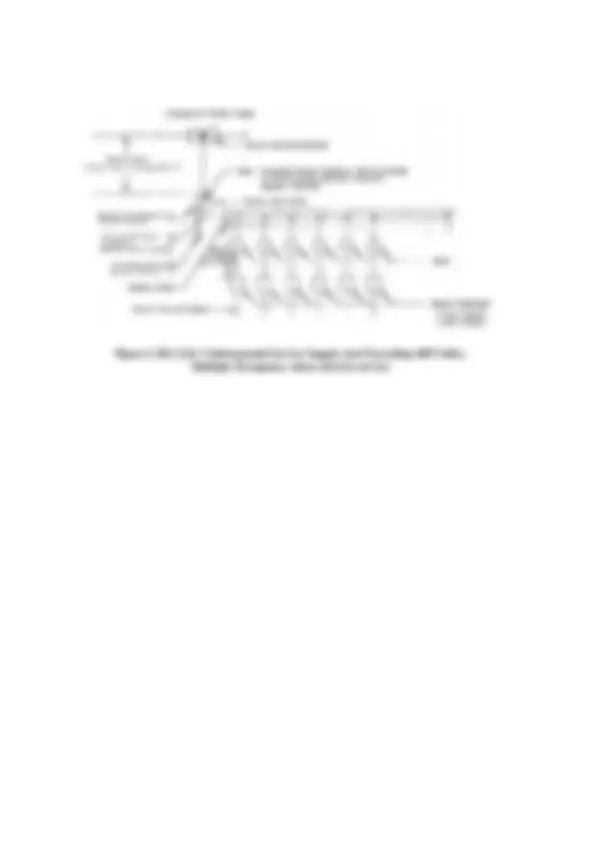
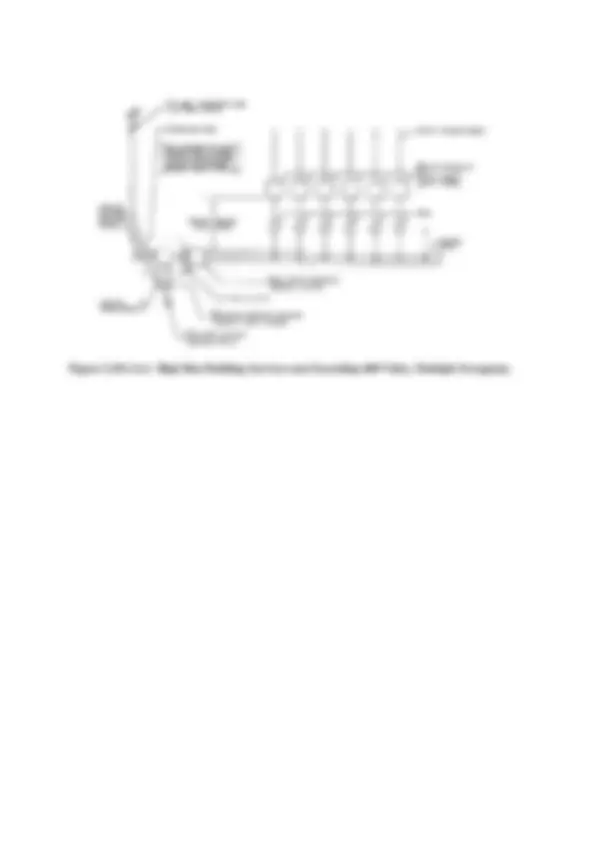
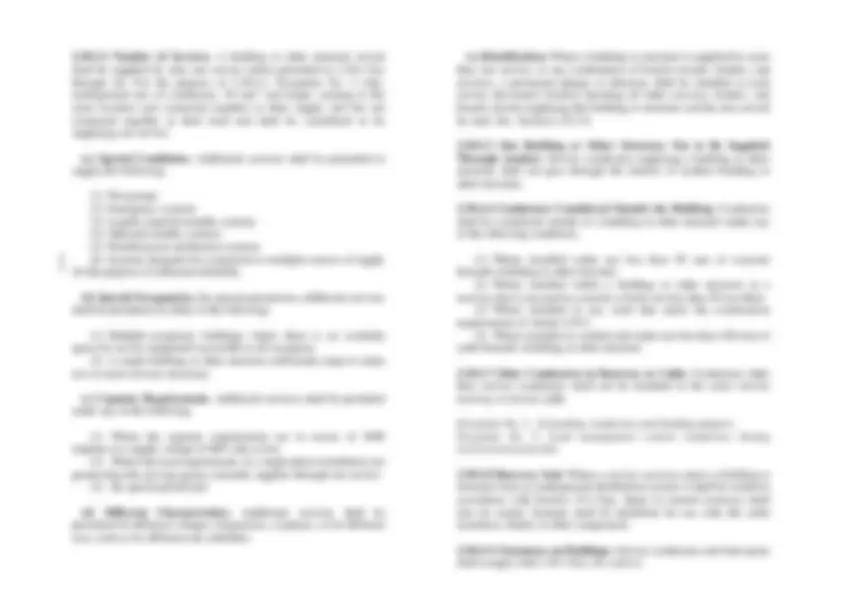
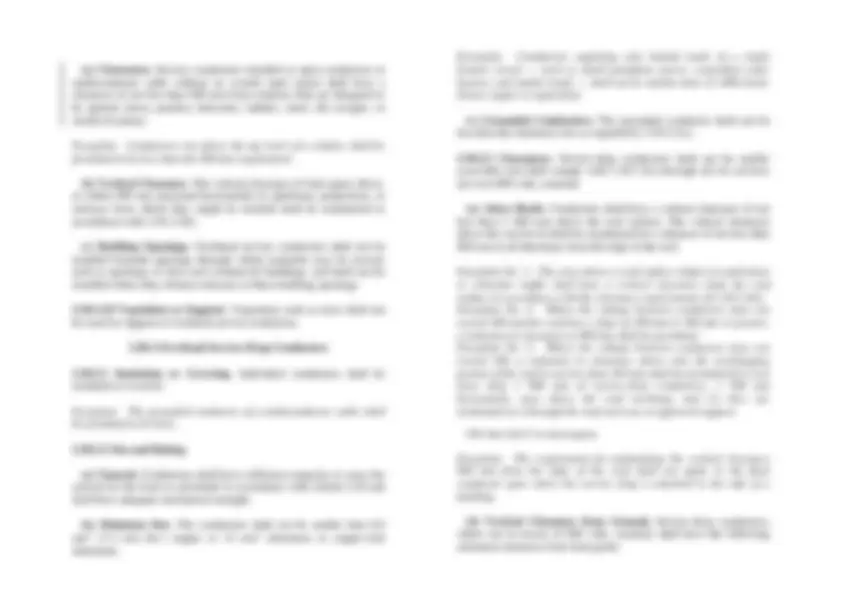
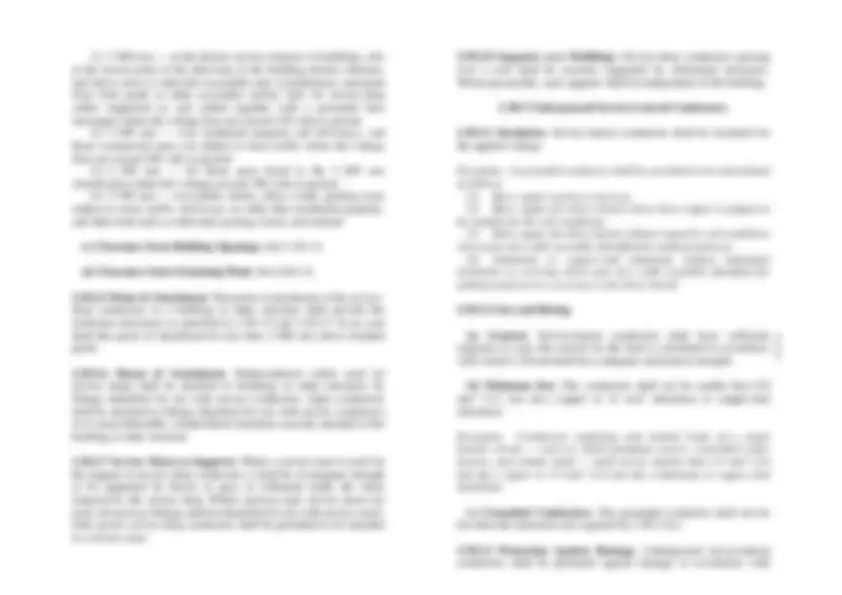
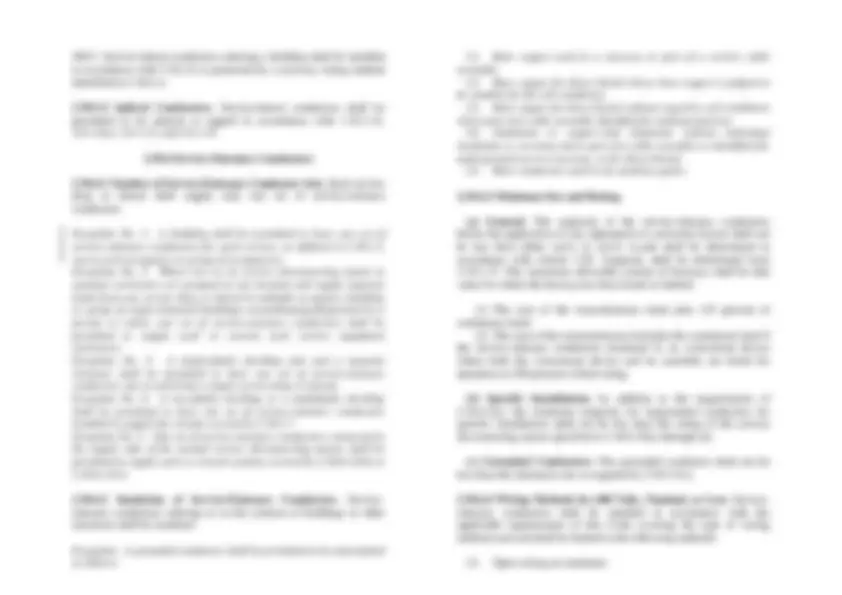
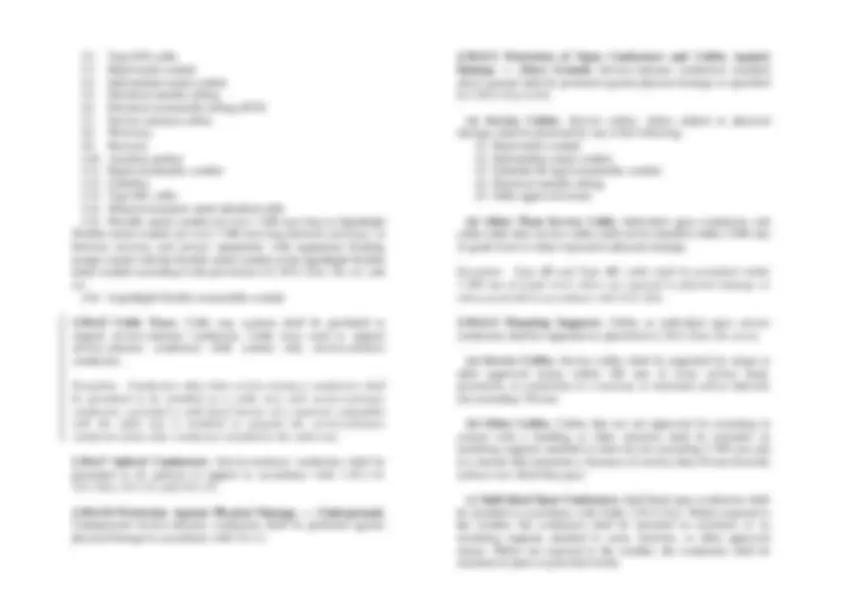
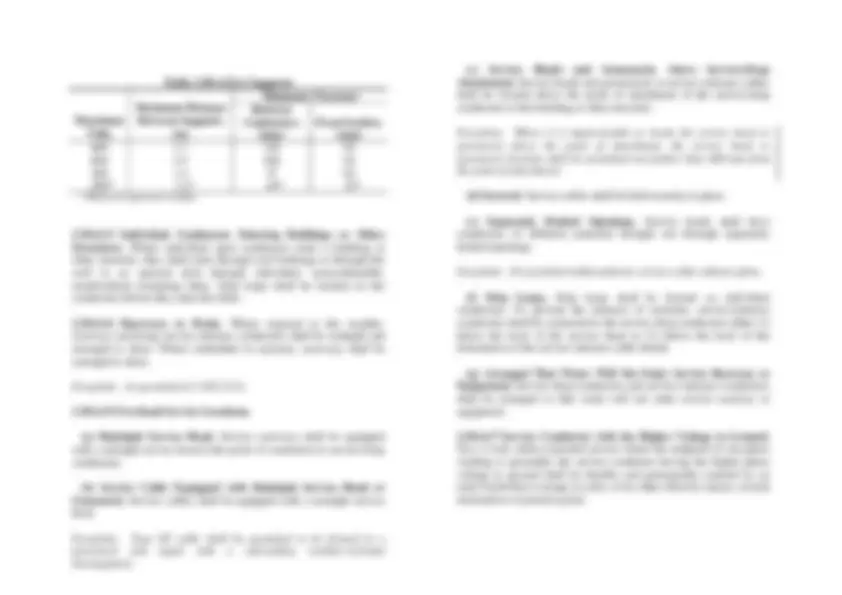
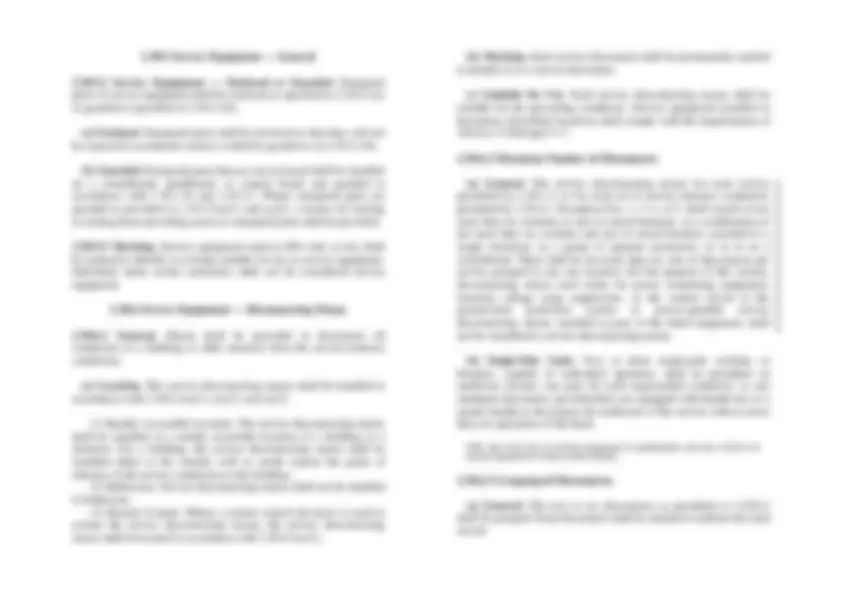
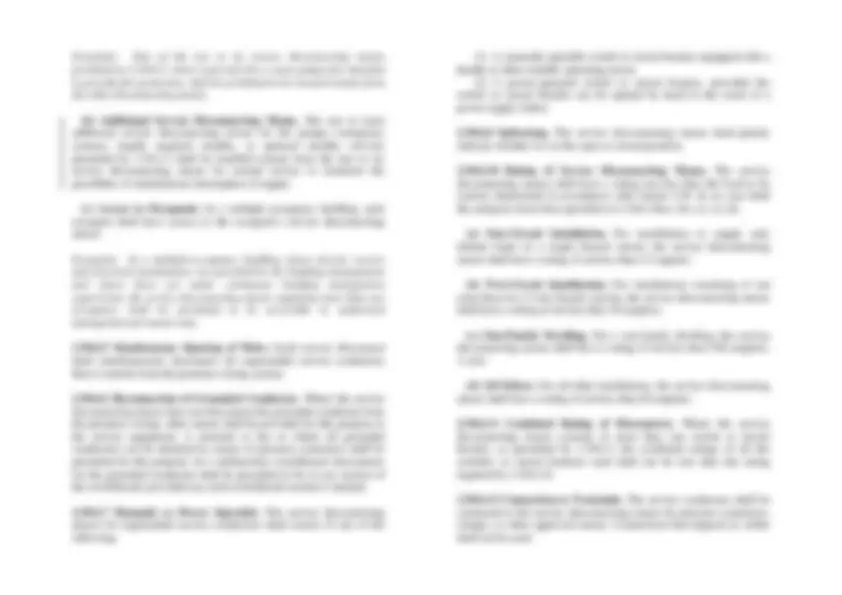
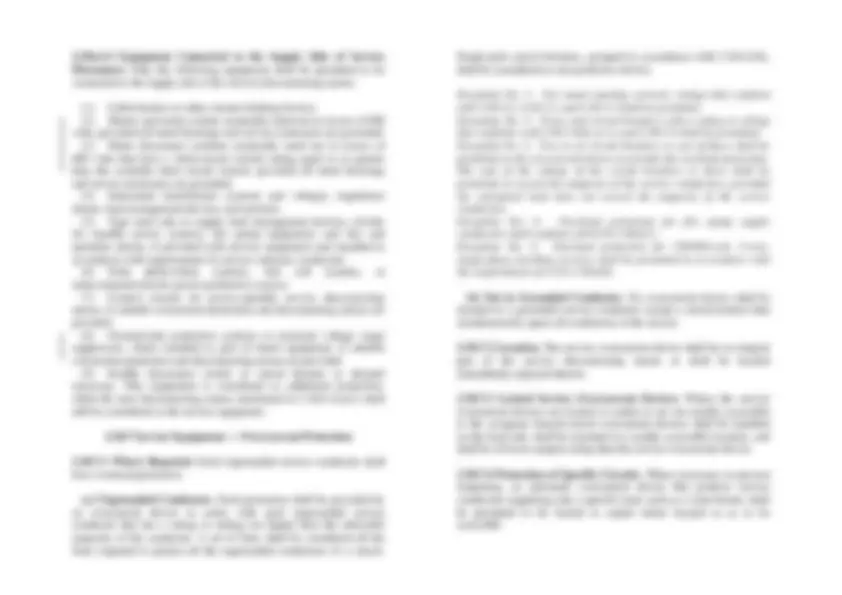
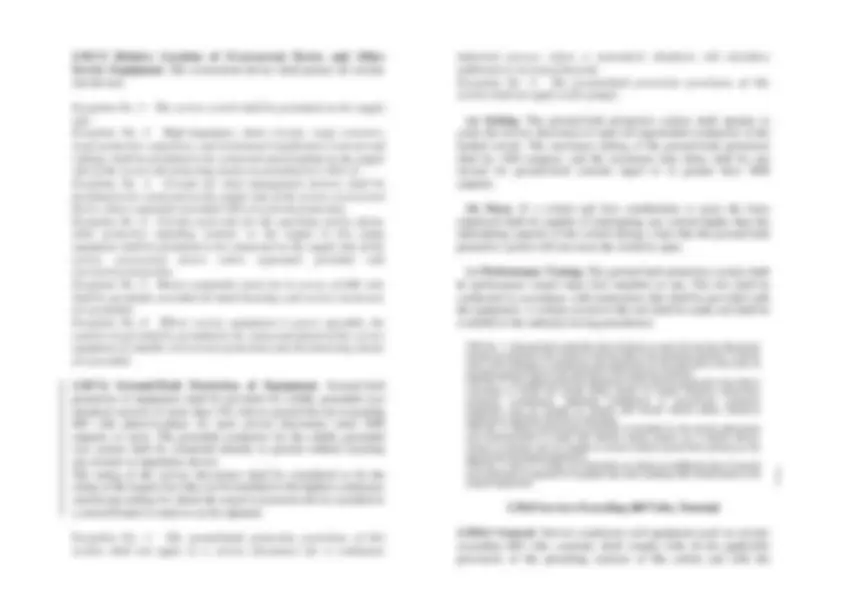
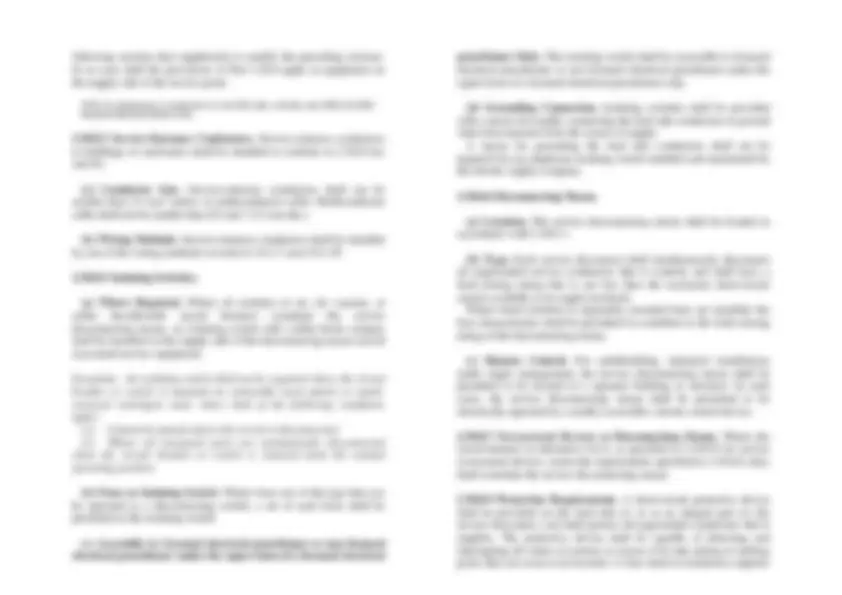
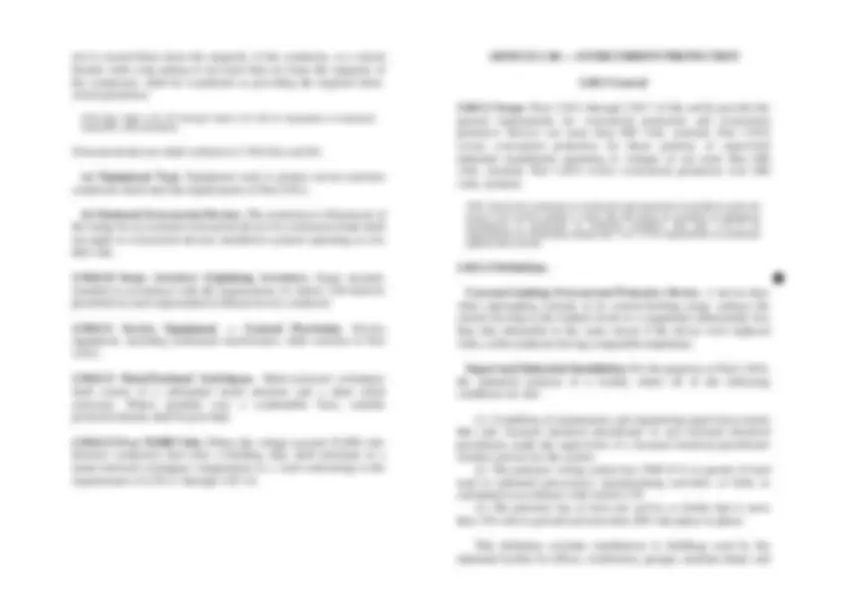
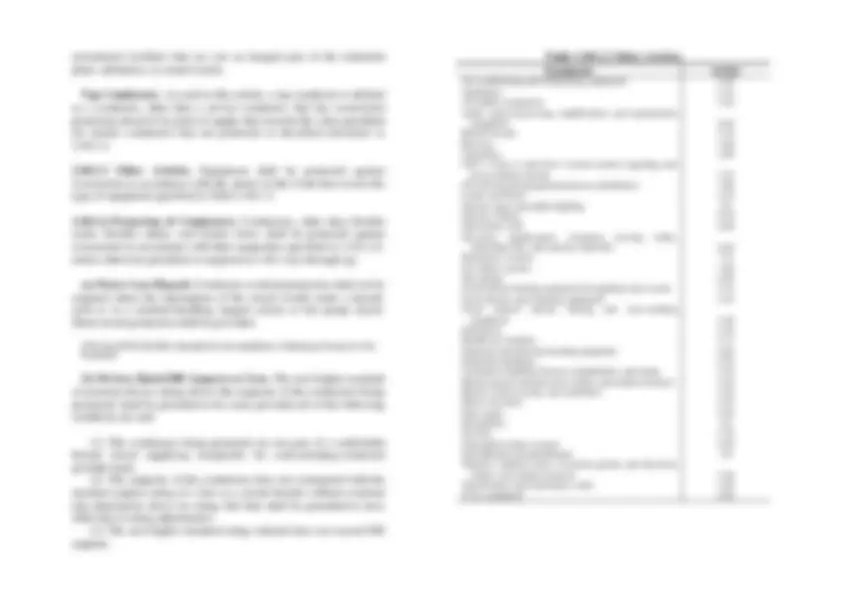
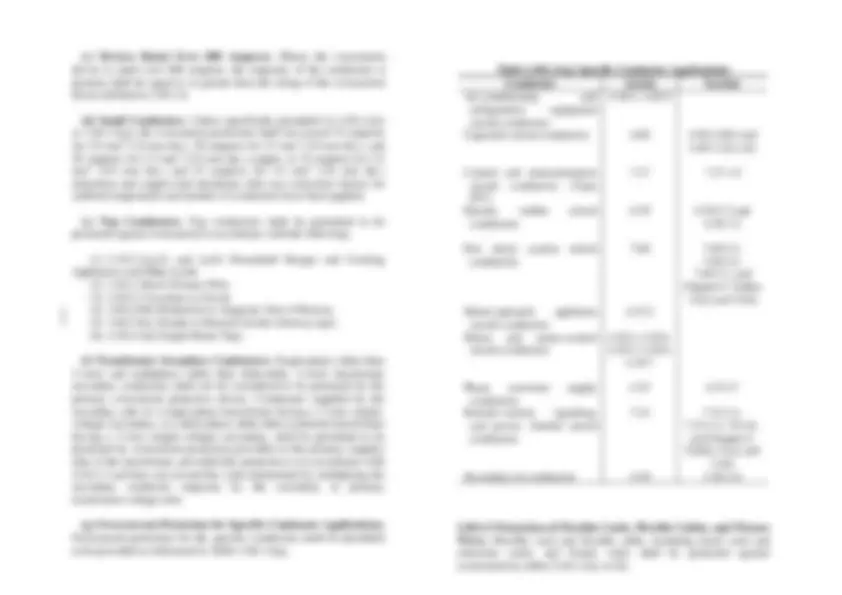
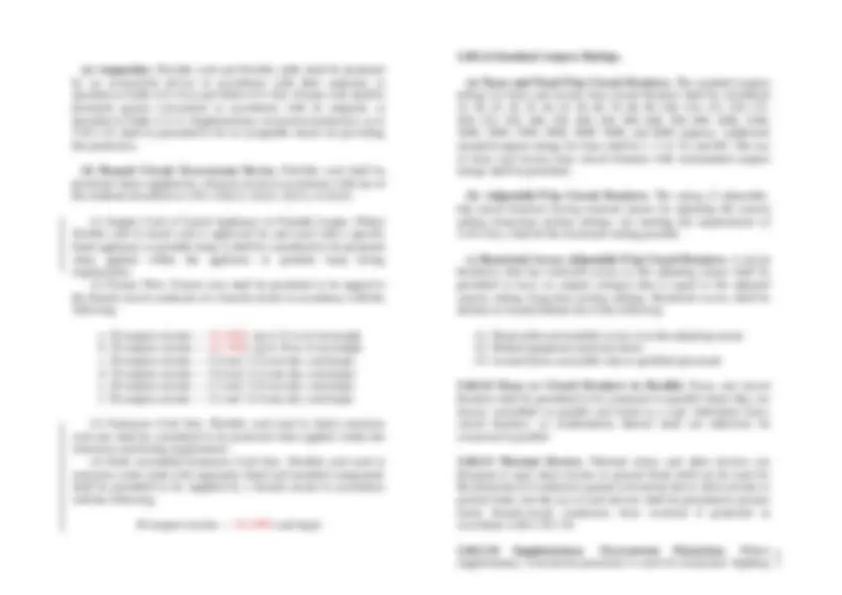
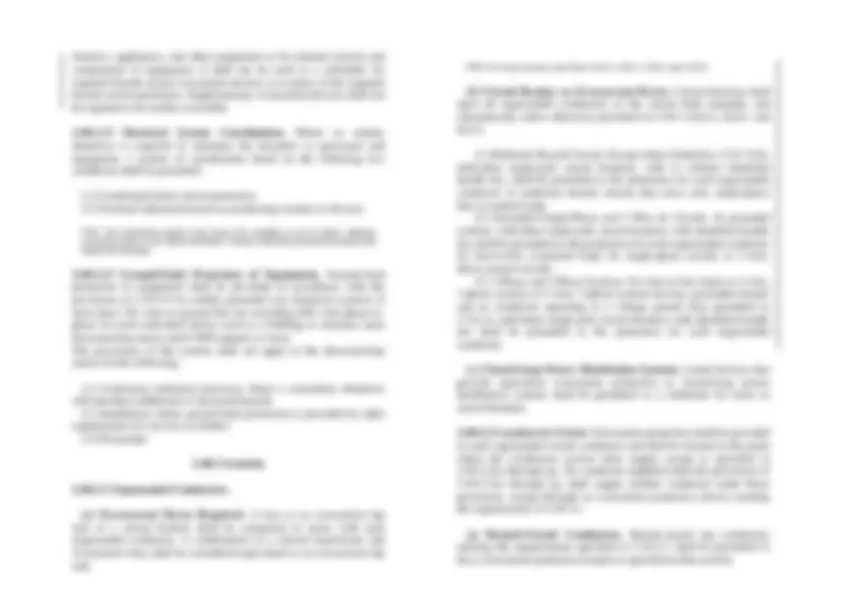
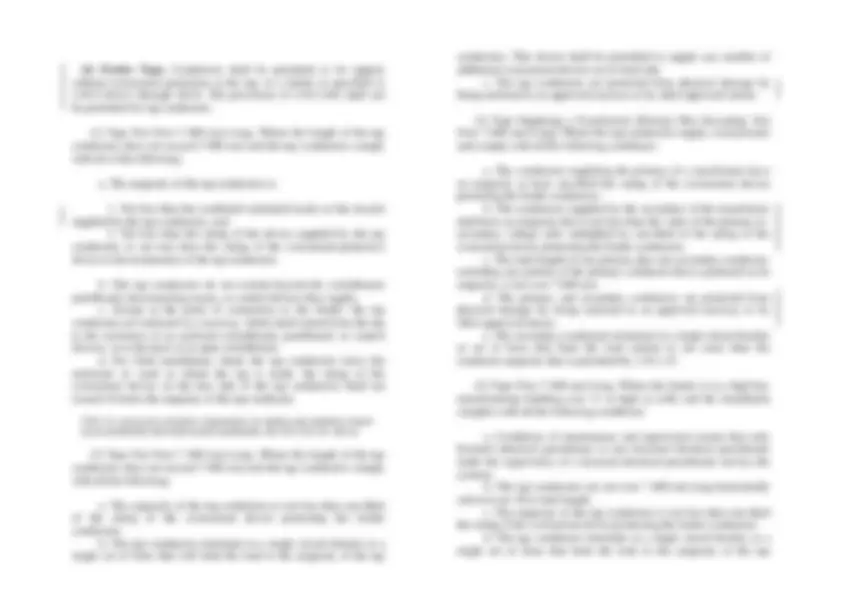
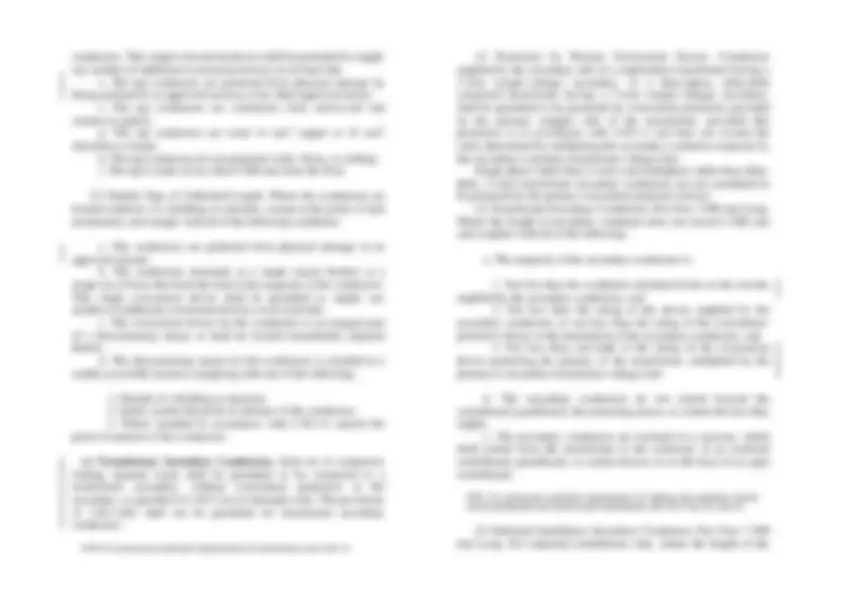
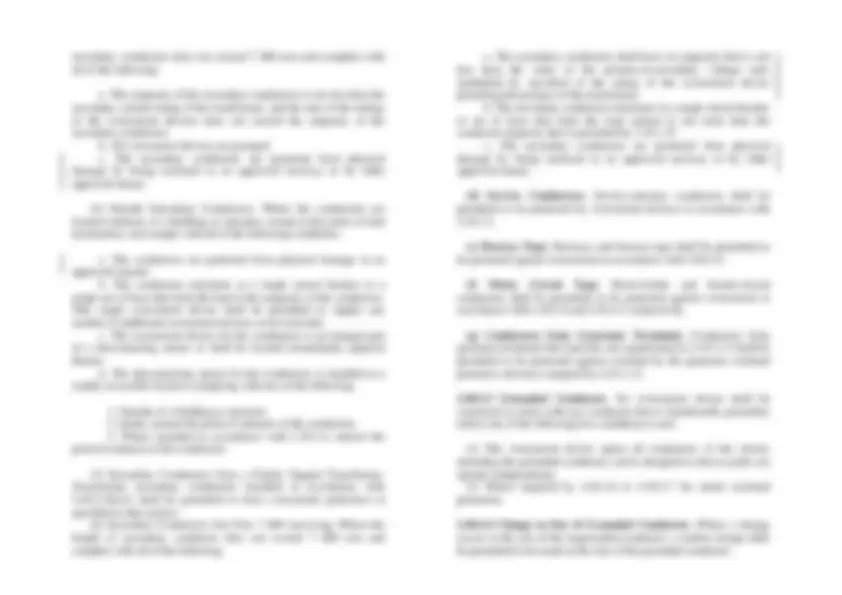
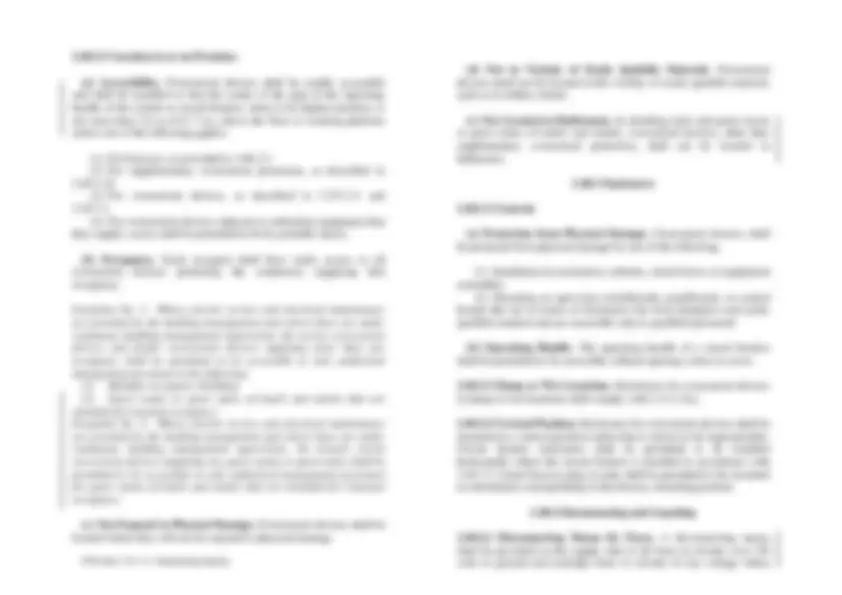


Study with the several resources on Docsity

Earn points by helping other students or get them with a premium plan


Prepare for your exams
Study with the several resources on Docsity

Earn points to download
Earn points by helping other students or get them with a premium plan
Community
Ask the community for help and clear up your study doubts
Discover the best universities in your country according to Docsity users
Free resources
Download our free guides on studying techniques, anxiety management strategies, and thesis advice from Docsity tutors
Guidelines for the layout and wiring of electrical equipment and motors, including their ratings, locations, and protective devices, in residential and small commercial buildings. It covers topics such as full-load current rating, frequency rating, emergency power system wiring, and ground-fault current paths. It also includes information on the use of raceways, cable trays, and type fcc cable for branch circuits.
Typology: Lecture notes
1 / 808

This page cannot be seen from the preview
Don't miss anything!





























































































Code^ is^ the practical safeguarding of persons and property from hazards arisingfrom the use of electricity.^ (b) Adequacy.^ This^ Code^ contains provisions that are consideredminimum requirements necessary for safety. Compliance therewithand proper maintenance will result in an installation that is essentiallyfree from hazard but not necessarily efficient, convenient, or adequatefor good service or future expansion of electrical use.^ FPN No. 1: Hazards often occur because of overloading of wiring systems bymethods or usage not in conformity with this
Code. This occurs because initial wiring did not provide for increases in the use of electricity. An initial adequateinstallation and reasonable provisions for system changes will provide for futureincreases in the use of electricity. FPN No 2: It is highly recommended that a licensed electrical practitioner beconsulted for any electrical requirements, including changes. Failure to do so mayresult in fire, serious injury, or death. FPN No. 3: Fire hazard, electrocution, serious injury or even death may also occurwith^ lack^ or^ improper^ maintenance^ of
wiring^ system.^ Wiring^ system^ is recommended to be inspected and tested by a licensed electrical practitioner atleast once a year for wiring system of more than three (3) years in installation. (c)^ Intention.^ This Code is intended for the exclusive use oflicensed electrical practitioners (PEE, REE, and RME). This
Code^ is not intended as a design specification nor an instruction manual for anon-licensed electrical practitioner, unless under the supervision of alicensed electrical practitioner.^ (d) Relation to Other International Standards.
The requirements in this^ Code^ address the fundamental principles of protection for safety
1.0.1.3 Authority.
contained in Section 131 of International Electrotechnical CommissionStandard 60364-1,^ Electrical Installations of Buildings
(a)^ This^ Code^ has been approved and adopted by the Board ofElectrical Engineering, Professional Regulation Commission. FPN: IEC 60364-1, Section 131. Contains fundamental principles of protection forsafety^ that^ encompass^ protection^ against
thermal^ effects,^ protection^ against overcurrent, protection against fault currents, and protection against overvoltage.All of these potential hazards are addressed by the requirements in this
Code.^ (b)^ By virtue of authority vested in the Board under RA 7920, ithereby direct strict adherence to the provisions of this
Code.
1.0.1.2 Scope.
(c)^ Where deviations from these provisions are necessary, suchdeviations shall not be made, except with written permission from thisgovernment bodies exercising legal jurisdiction applicable only to theparticular job for which such permission was granted. (a)^ Covered.^ This^ Code^ covers
the^ installation^ of^ electrical conductors, equipment, and raceways;
signaling^ and communications conductors, equipment, and raceways; and optical fiber cables andraceways installed within or on, to or from:
1.0.1.4 Enforcement. (1) Public and private buildings, including but not limited toresidential, commercial, industrial, institutional, cultural, agricultural,agro-industrial,^ planned^ unit^ development
and^ all^ other buildings/premises that may require practical safeguarding of personsand property from the hazards arising from the use of electricity.
(a)^ This^ Code^ is intended for mandatory application by governmentbodies exercising legal jurisdiction over electrical installations. (b)^ These government bodies, only through a licensed electricalpractitioner,^ shall^ have^ the^ responsibility
of^ implementing^ the provisions of this^ Code^ in deciding on the approval of equipment andmaterials and for granting the special permission contemplated in this Code,^ where it is assured that equivalent objectives can be achieved byestablishing and maintaining effective safety. (2) Electric generating plants (3) Industrial plants (4) Transformer stations (5) Permanent and temporary substations, etc. (6) Airfields (7) Railways switchyards (8) Yards, carnival, parks, parking and other lots
(c)^ The^ authority^ having^ jurisdiction
may^ waive^ specific requirements in this^ Code^ or permit alternate methods where it isassured that equivalent objectives can be achieved by establishing andmaintaining effective safety. (9) Quarries and mines (10) Watercraft (11) Dockyards (12) Trailers (13) Mobile homes and recreational vehicles
(d)^ This^ Code^ may require new products, constructions, or materialsthat may not yet be available at the time this
Code^ is adopted. In such event, the authority having jurisdiction may permit the use of theproducts, constructions, or materials that comply with the most recentprevious edition of this^ Code^ adopted by the jurisdiction. (14) Offshore facilities (b) Not Covered.^ This^ Code^ does not cover the following: (1) Installations in railway rolling stock, aircraft, or automotivevehicles^
FPN: Application of electrical products and equipment for additional installation orreplacement is suggested to be consulted with a licensed electrical practitionerprior to installation for safety. (2)^ Installations^ of^ railways^ for
generation,^ transformation, transmission, or distribution of power used exclusively for operationof rolling stock
1.1.1 General^
FPN: The phrase “authority having jurisdiction” is used in NFPA documents in abroad^ manner,^ since^ jurisdictions^ and^
approval^ agencies^ vary,^ as^ do^ their responsibilities. Where public safety is primary, the AHJ may be a federal, state,local, or other regional department or individual such as a fire chief; fire marshal;chief of a fire prevention bureau, labor department, or health department; buildingofficial; electrical inspector; or others having statutory authority. For insurancepurposes, an insurance inspection department, rating bureau, or other insurancecompany representative may be the AHJ. In many circumstances, the propertyowner or his or her designated agent assumes the role of the AHJ; at governmentinstallations, the commanding officer or departmental official may be the AHJ. Accessible (as applied to equipment).
Admitting close approach; not guarded by locked doors, elevation, or other effective means.^ Accessible (as applied to wiring methods).
Capable of being removed or exposed without damaging the building structure or finishor not permanently closed in by the structure or finish of the building.
Automatic.^ Self-acting, operating by its own mechanism whenactuated by some impersonal influence, as, for example, a change incurrent, pressure, temperature, or mechanical configuration. Accessible,^ Readily^ (Readily^
Accessible).^ Capable^ of^ being reached^ quickly^ for^ operation,^
renewal,^ or^ inspections^ without requiring those to whom ready access is requisite to climb over orremove obstacles or to resort to portable ladders, and so forth.^ Ampacity.^ The current, in amperes, that a conductor can carrycontinuously^ under^ the^ conditions
of^ use^ without^ exceeding^ its temperature rating.^ Appliance.^ Utilization equipment, generally other than industrial,that is normally built in standardized sizes or types and is installed orconnected as a unit to perform one or more functions such as clotheswashing, air conditioning, food mixing, deep frying, and so forth.^ Approved.^ Acceptable to the authority having jurisdiction.^ Askarel.^ A generic term for a group of nonflammable syntheticchlorinated hydrocarbons used as electrical insulating media. Askarelsof various compositional types are used. Under arcing conditions, thegases produced, while consisting predominantly of noncombustiblehydrogen chloride, can include varying amounts of combustible gases,depending on the askarel type.^ Attachment Plug (Plug Cap) (Plug).
A device that, by insertion in a receptacle, establishes a connection between the conductors of theattached flexible cord and the conductors connected permanently tothe receptacle.^ Authority Having Jurisdiction (AHJ).
The organization, office, or individual^ responsible^ for^ approving
equipment,^ materials,^ an installation, or a procedure.
Bathroom.^ An area including a basin with one or more of thefollowing: a toilet, a tub, or a shower. Bonding (Bonded).^ The permanent joining of metallic parts to forman electrically conductive path that ensures electrical continuity andthe capacity to conduct safely any current likely to be imposed. Bonding Jumper.^ A reliable conductor to ensure the requiredelectrical conductivity between metal parts required to be electricallyconnected. Bonding Jumper, Equipment.^ The connection between two or more portions of the equipment grounding conductor.^ Bonding Jumper, Main.^ The connection between the groundedcircuit^ conductor^ and^ the^ equipment
grounding^ conductor^ at^ the service.^ Bonding Jumper, System.^ The connection between the groundedcircuit^ conductor^ and^ the^ equipment
grounding^ conductor^ at^ a separately derived system.^ Branch^ Circuit.^ The^ circuit
conductors^ between^ the^ final overcurrent device protecting the circuit and the outlet(s).^ Branch Circuit, Appliance.^ A branch circuit that supplies energy toone or more outlets to which appliances are to be connected and that
has no permanently connected luminaires (lighting fixtures) that arenot a part of an appliance.^ Branch Circuit, General-Purpose.
A branch circuit that supplies two or more receptacles or outlets for lighting and appliances.^ Branch Circuit, Individual.^ A branch circuit that supplies only oneutilization equipment.^ Branch Circuit, Multiwire.^ A branch circuit that consists of two ormore ungrounded conductors that have a voltage between them, and agrounded^ conductor^ that^ has^ equal
voltage^ between^ it^ and^ each ungrounded conductor of the circuit and that is connected to theneutral or grounded conductor of the system.^ Building.^ A structure that stands alone or that is cut off fromadjoining structures by fire walls with all openings therein protectedby approved fire doors.^ Cabinet.^ An enclosure that is designed for either surface mountingor flush mounting and is provided with a frame, mat, or trim in whicha swinging door or doors are or can be hung.^ Circuit Breaker.^ A device designed to open and close a circuit bynonautomatic^ means^ and^ to^ open
the^ circuit^ automatically^ on^ a predetermined overcurrent without damage to itself when properlyapplied within its rating.^ FPN: The automatic opening means can be integral, direct acting with the circuitbreaker, or remote from the circuit breaker.^ Adjustable (as applied to circuit breakers).
A qualifying term indicating that the circuit breaker can be set to trip at various values ofcurrent, time, or both, within a predetermined range.^ Instantaneous Trip (as applied to circuit breakers).
A qualifying term indicating that no delay is purposely introduced in the trippingaction of the circuit breaker.^ Inverse Time (as applied to circuit breakers).
A qualifying term indicating that there is purposely introduced a delay in the tripping
action of the circuit breaker, which delay decreases as the magnitudeof the current increases.^ Nonadjustable (as applied to circuit breakers).
A qualifying term indicating that the circuit breaker does not have any adjustment to alterthe value of current at which it will trip or the time required for itsoperation.^ Setting (of circuit breakers).^ The value of current, time, or both, atwhich an adjustable circuit breaker is set to trip.^ Concealed.^ Rendered inaccessible by the structure or finish of thebuilding. Wires in concealed raceways are considered concealed, eventhough they may become accessible by withdrawing them.^ Conductor, Bare.^ A conductor having no covering or electricalinsulation whatsoever.^ Conductor,^ Covered.^ A^ conductor
encased^ within^ material^ of composition or thickness that is not recognized by this Code aselectrical insulation.^ Conductor, Insulated.^ A conductor encased within material ofcomposition and thickness that is recognized by this Code as electricalinsulation.^ Conduit Body.^ A separate portion of a conduit or tubing system thatprovides access through a removable cover(s) to the interior of thesystem at a junction of two or more sections of the system or at aterminal point of the system.^ Boxes such as FS and FD or larger cast or sheet metal boxes are notclassified as conduit bodies.^ Connector,^ Pressure^ (Solderless).
A^ device^ that^ establishes^ a connection between two or more conductors or between one or moreconductors and a terminal by means of mechanical pressure andwithout the use of solder.^ Continuous Load.^ A load where the maximum current is expectedto continue for 3 hours or more.
Festoon Lighting.^ A string of outdoor lights that is suspendedbetween two points.
Enclosed.^ Surrounded by a case, housing, fence, or wall(s) thatprevents persons from accidentally contacting energized parts.
Fitting.^ An accessory such as a locknut, bushing, or other part of awiring system that is intended primarily to perform a mechanicalrather than an electrical function. Enclosure.^ The case or housing of apparatus, or the fence or wallssurrounding an installation to prevent personnel from accidentallycontacting energized parts or to protect the equipment from physicaldamage.^
Garage.^ A building or portion of a building in which one or moreself-propelled vehicles can be kept for use, sale, storage, rental, repair,exhibition, or demonstration purposes. FPN: See Table 4.30.7.11 for examples of enclosure types. Energized.^ Electrically connected to a source of voltage.
FPN: For commercial garages, repair and storage, see Article 5.11. Equipment.^ A general term including material, fittings, devices,appliances, luminaires (fixtures), apparatus, and the like used as a partof, or in connection with, an electrical installation.
Ground.^ A^ conducting^ connection,
whether^ intentional^ or accidental, between an electrical circuit or equipment and the earth orto some conducting body that serves in place of the earth. Explosionproof Apparatus.^ Apparatus enclosed in a case that iscapable of withstanding an explosion of a specified gas or vapor thatmay occur within it and of preventing the ignition of a specified gas orvapor surrounding the enclosure by sparks, flashes, or explosion of thegas or vapor within, and that operates at such an external temperaturethat a surrounding flammable atmosphere will not be ignited thereby.
Grounded.^ Connected to earth or to some conducting body thatserves in place of the earth. Grounded, Effectively.^ Intentionally connected to earth through aground connection or connections of sufficiently low impedance andhaving sufficient current-carrying capacity to prevent the buildup ofvoltages that may result in undue hazards to connected equipment orto persons. FPN: For further information, see ANSI/UL 1203-1999, Explosion-Proof and Dust-Ignition-Proof Electrical Equipment for Use in Hazardous (Classified) Locations.
Grounded, Solidly.^ Connected to ground without inserting anyresistor or impedance device. Exposed (as applied to live parts).
Capable of being inadvertently touched or approached nearer than a safe distance by a person. It isapplied to parts that are not suitably guarded, isolated, or insulated.^ Exposed (as applied to wiring methods).
On or attached to the surface or behind panels designed to allow access.^ Externally Operable.^ Capable of being operated without exposingthe operator to contact with live parts.^ Feeder.^ All circuit conductors between the service equipment, thesource of a separately derived system, or other power supply sourceand the final branch-circuit overcurrent device.
Grounded^ Conductor.^ A^ system
or^ circuit^ conductor^ that^ is intentionally grounded.^ Ground-Fault Circuit Interrupter (GFCI).
A device intended for the protection of personnel that functions to de-energize a circuit orportion thereof within an established period of time when a current toground exceeds the values established for a Class A device.^ FPN: Class A ground-fault circuit interrupters trip when the current to ground has avalue in the range of 4 mA to 6 mA. For further information, see UL 943, Standardfor Ground-Fault Circuit Interrupters.
Ground-Fault Protection of Equipment.
A system intended to provide protection of equipment from damaging line-to-ground faultcurrents by operating to cause a disconnecting means to open allungrounded^ conductors^ of^ the^ faulted^ circuit.^ This^ protection^
is provided^ at^ current^ levels^ less
than^ those^ required^ to^ protect conductors from damage through the operation of a supply circuitovercurrent device.^ Grounding Conductor.^ A conductor used to connect equipment orthe grounded circuit of a wiring system to a grounding electrode orelectrodes.^ Grounding^ Conductor,^ Equipment.
The^ conductor^ used^ to connect the non–current-carrying metal parts of equipment, raceways,and other enclosures to the system grounded conductor, the groundingelectrode conductor, or both, at the service equipment or at the sourceof a separately derived system.^ Grounding^ Electrode.^ A^ device
that^ establishes^ an^ electrical connection to the earth.^ Grounding Electrode Conductor.
The conductor used to connect the grounding electrode(s) to the equipment grounding conductor, tothe grounded conductor, or to both, at the service, at each building orstructure where supplied by a feeder(s) or branch circuit(s), or at thesource of a separately derived system.^ Guarded.^ Covered,^ shielded, fenced,^ enclosed,^ or^ otherwise protected by means of suitable covers, casings, barriers, rails, screens,mats, or platforms to remove the likelihood of approach or contact bypersons or objects to a point of danger.^ Guest^ Room.^ An^ accommodation
combining^ living,^ sleeping, sanitary, and storage facilities within a compartment.^ Guest Suite.^ An accommodation with two or more contiguousrooms comprising a compartment, with or without doors between suchrooms, that provides living, sleeping, sanitary, and storage facilities.^ Handhole^ Enclosure.^ An^ enclosure
identified^ for^ use^ in underground systems, provided with an open or closed bottom, and
sized to allow personnel to reach into, but not enter, for the purpose ofinstalling, operating, or maintaining equipment or wiring or both.^ Hoistway.^ Any shaftway, hatchway, well hole, or other verticalopening or space in which an elevator or dumbwaiter is designed tooperate.^ Identified (as applied to equipment).
Recognizable as suitable for the specific purpose, function, use, environment, application, and soforth, where described in a particular Code requirement.^ FPN: Some examples of ways to determine suitability of equipment for a specificpurpose, environment, or application include investigations by a qualified testinglaboratory^ (listing^ and^ labeling),^ an^ inspection
agency,^ or^ other^ organizations concerned with product evaluation. In Sight From (Within Sight From, Within Sight).
Where this Code specifies that one equipment shall be “in sight from,” “withinsight from,” or “within sight,” and so forth, of another equipment, thespecified equipment is to be visible and not more than 15 m distantfrom the other.^ Interrupting Rating.^ The highest current at rated voltage that adevice is intended to interrupt under standard test conditions.^ FPN: Equipment intended to interrupt current at other than fault levels may have itsinterrupting rating implied in other ratings, such as horsepower or locked rotorcurrent.^ Isolated (as applied to location).
Not readily accessible to persons unless special means for access are used.^ Labeled.^ Equipment or materials to which has been attached a label,symbol, or other identifying mark of an organization that is acceptableto^ the^ authority^ having^ jurisdiction
and^ concerned^ with^ product evaluation, that maintains periodic inspection of production of labeledequipment or materials, and by whose labeling the manufacturerindicates compliance with appropriate standards or performance in aspecified manner.^ Lighting Outlet.^ An outlet intended for the direct connection of alampholder,^ a^ luminaire^ (lighting
fixture),^ or^ a^ pendant^ cord terminating in a lampholder.
Overload.^ Operation of equipment in excess of normal, full-loadrating, or of a conductor in excess of rated ampacity that, when itpersists^ for^ a^ sufficient^ length^ of
time,^ would^ cause^ damage^ or dangerous overheating. A fault, such as a short circuit or ground fault,is not an overload.^ Panelboard.^ A single panel or group of panel units designed forassembly in the form of a single panel, including buses and automaticovercurrent devices, and equipped with or without switches for thecontrol of light, heat, or power circuits; designed to be placed in acabinet or cutout box placed in or against a wall, partition, or othersupport; and accessible only from the front.^ Plenum.^ A compartment or chamber to which one or more air ductsare connected and that forms part of the air distribution system.^ Power Outlet.^ An enclosed assembly that may include receptacles,circuit breakers, fuseholders, fused switches, buses, and watt-hourmeter mounting means; intended to supply and control power tomobile homes, recreational vehicles, park trailers, or boats or to serveas a means for distributing power required to operate mobile ortemporarily installed equipment.^ Premises^ Wiring^ (System).^ That
interior^ and^ exterior^ wiring, including power, lighting, control, and signal circuit wiring togetherwith all their associated hardware, fittings, and wiring devices, bothpermanently and temporarily installed, that extends from the servicepoint or source of power, such as a battery, a solar photovoltaicsystem, or a generator, transformer, or converter windings, to theoutlet(s). Such wiring does not include wiring internal to appliances,luminaires (fixtures), motors, controllers, motor control centers, andsimilar equipment.^ Raceway.^ An enclosed channel of metal or nonmetallic materialsdesigned^ expressly^ for^ holding^
wires,^ cables,^ or^ busbars,^ with additional functions as permitted in this Code. Raceways include, butare not limited to, rigid metal conduit, rigid nonmetallic conduit,intermediate^ metal^ conduit,^ liquidtight
flexible^ conduit,^ flexible metallic tubing, flexible metal conduit, electrical nonmetallic tubing,electrical metallic tubing, underfloor raceways, cellular concrete floor
raceways, cellular metal floor raceways, surface raceways, wireways,and busways.^ Rainproof.^ Constructed, protected, or treated so as to prevent rainfrom interfering with the successful operation of the apparatus underspecified test conditions.^ Raintight.^ Constructed or protected so that exposure to a beatingrain will not result in the entrance of water under specified testconditions.^ Receptacle.^ A receptacle is a contact device installed at the outletfor the connection of an attachment plug. A single receptacle is asingle contact device with no other contact device on the same yoke. Amultiple receptacle is two or more contact devices on the same yoke.^ Receptacle Outlet.^ An outlet where one or more receptacles areinstalled.^ Remote-Control Circuit.^ Any electric circuit that controls anyother circuit through a relay or an equivalent device.^ Sealable Equipment.^ Equipment enclosed in a case or cabinet thatis provided with a means of sealing or locking so that live parts cannotbe made accessible without opening the enclosure. The equipmentmay or may not be operable without opening the enclosure.^ Separately Derived System.^
A premises wiring system whose power is derived from a source of electric energy or equipment otherthan a service. Such systems have no direct electrical connection,including a solidly connected grounded circuit conductor, to supplyconductors originating in another system.^ Service.^ The^ conductors^ and^
equipment^ for^ delivering^ electric energy from the serving utility to the wiring system of the premisesserved.^ Service Cable.^ Service conductors made up in the form of a cable.^ Service Conductors.^ The conductors from the service point to theservice disconnecting means.
Solar Photovoltaic System.^ The total components and subsystemsthat,^ in^ combination,^ convert^ solar
energy^ into^ electrical^ energy suitable for connection to a utilization load.
Service Drop.^ The overhead service conductors from the last poleor other aerial support to and including the splices, if any, connectingto the service-entrance conductors at the building or other structure.
Special Permission.^ The written consent of the authority havingjurisdiction. Service-Entrance^ Conductors,^
Overhead^ System.^ The^ service conductors between the terminals of the service equipment and a pointusually outside the building, clear of building walls, where joined bytap or splice to the service drop.^
Structure.^ That which is built or constructed. Service-Entrance^ Conductors,^
Underground^ System.^ The service conductors between the terminals of the service equipment andthe point of connection to the service lateral.^ FPN: Where service equipment is located outside the building walls, there may beno service-entrance conductors or they may be entirely outside the building.^ Service Equipment.^ The necessary equipment, usually consistingof a circuit breaker(s) or switch(es) and fuse(s) and their accessories,connected to the load end of service conductors to a building or otherstructure, or an otherwise designated area, and intended to constitutethe main control and cutoff of the supply.^ Service Lateral.^ The underground service conductors between thestreet main, including any risers at a pole or other structure or fromtransformers, and the first point of connection to the service-entranceconductors in a terminal box or meter or other enclosure, inside oroutside the building wall. Where there is no terminal box, meter, orother enclosure, the point of connection is considered to be the pointof entrance of the service conductors into the building.^ Service Point.^ The point of connection between the facilities of theserving utility and the premises wiring.^ Show Window.^ Any window used or designed to be used for thedisplay of goods or advertising material, whether it is fully or partlyenclosed or entirely open at the rear and whether or not it has aplatform raised higher than the street floor level.^ Signaling Circuit.^ Any electric circuit that energizes signalingequipment.
Supplementary^ Overcurrent^
Protective^ Device.^ A^ device intended^ to^ provide^ limited^ overcurrent
protection^ for^ specific applications and utilization equipment such as luminaires (lightingfixtures) and appliances. This limited protection is in addition to theprotection provided in the required branch circuit by the branch circuitovercurrent protective device.^ Switch, Bypass Isolation.^ A manually operated device used inconjunction with a transfer switch to provide a means of directlyconnecting load conductors to a power source and of disconnecting thetransfer switch.^ Switch,^ General-Use.^ A^ switch
intended^ for^ use^ in^ general distribution and branch circuits. It is rated in amperes, and it is capableof interrupting its rated current at its rated voltage.^ Switch,^ General-Use^ Snap.^
A^ form^ of^ general-use^ switch constructed so that it can be installed in device boxes or on box covers,or otherwise used in conjunction with wiring systems recognized bythis Code.^ Switch, Isolating.^ A switch intended for isolating an electric circuitfrom the source of power. It has no interrupting rating, and it isintended to be operated only after the circuit has been opened by someother means.^ Switch, Motor-Circuit.^ A switch rated in horsepower that iscapable of interrupting the maximum operating overload current of amotor of the same horsepower rating as the switch at the rated voltage.
through it.^ FPN: A fuse comprises all the parts that form a unit capable of performing theprescribed functions. It may or may not be the complete device necessary toconnect it into an electrical circuit.^ Controlled^ Vented^ Power^ Fuse.
A^ fuse^ with^ provision^ for controlling discharge circuit interruption such that no solid materialmay be exhausted into the surrounding atmosphere.^ FPN: The fuse is designed so that discharged gases will not ignite or damageinsulation in the path of the discharge or propagate a flashover to or betweengrounded members or conduction members in the path of the discharge where thedistance between the vent and such insulation or conduction members conforms tomanufacturer’s recommendations.^ Expulsion Fuse Unit (Expulsion Fuse).
A vented fuse unit in which the expulsion effect of gases produced by the arc and lining ofthe fuseholder, either alone or aided by a spring, extinguishes the arc.^ Nonvented Power Fuse.^ A fuse without intentional provision for theescape of arc gases, liquids, or solid particles to the atmosphere duringcircuit interruption.^ Power Fuse Unit.^ A vented, nonvented, or controlled vented fuseunit in which the arc is extinguished by being drawn through solidmaterial, granular material, or liquid, either alone or aided by a spring.^ Vented Power Fuse.^ A fuse with provision for the escape of arcgases, liquids, or solid particles to the surrounding atmosphere duringcircuit interruption.^ Multiple Fuse.^ An assembly of two or more single-pole fuses.^ Switching Device.^ A device designed to close, open, or both, one ormore electric circuits.^ Circuit Breaker.^ A switching device capable of making, carrying,and interrupting currents under normal circuit conditions, and also ofmaking, carrying for a specified time, and interrupting currents underspecified abnormal circuit conditions, such as those of short circuit.^ Cutout.^ An assembly of a fuse support with either a fuseholder, fuse
carrier, or disconnecting blade. The fuseholder or fuse carrier mayinclude^ a^ conducting^ element^
(fuse^ link)^ or^ may^ act^ as^ the disconnecting blade by the inclusion of a nonfusible member.^ Disconnecting (or Isolating) Switch (Disconnector, Isolator).
mechanical switching device used for isolating a circuit or equipmentfrom a source of power.^ Disconnecting Means.^ A device, group of devices, or other meanswhereby the conductors of a circuit can be disconnected from theirsource of supply.^ Interrupter Switch.^ A switch capable of making, carrying, andinterrupting specified currents.^ Oil Cutout (Oil-Filled Cutout).
A cutout in which all or part of the fuse support and its fuse link or disconnecting blade is mounted in oilwith complete immersion of the contacts and the fusible portion of theconducting element (fuse link) so that arc interruption by severing ofthe fuse link or by opening of the contacts will occur under oil.^ Oil Switch.^ A switch having contacts that operate under oil (oraskarel or other suitable liquid).^ Regulator Bypass Switch.^ A specific device or combination ofdevices designed to bypass a regulator.^ ARTICLE 1.2 — PERMITS AND^ INSPECTION CERTIFICATES^ 1.2.1 Electrical Permits 1.2.1.1 Electrical Permit Needed Before Work is Started.
Before starting any installation work, alternation, repair or extension on anyelectrical system, the owners, lessors, operators, occupants, or licensedelectrical practitioners shall obtain Electrical Permit for buildings,trailers, mobile homes, or other premises from the Office of the LocalBuilding Official, and for watercrafts from the Maritime IndustryAuthority (Marina). In securing the electrical permit, the services of a
Licensed^ Electrical^ Practitioner^
in-charge^ of^ the^ design,^ and^ the licensed electrical practitioner in-charge of the installation shall post acopy of their respective Professional Regulation Commission (PRC)identification card together with the electrical permit at all times.
licensed electrical practitioner is required under the New ElectricalEngineering Law (RA 7920). 1.2.1.2 Requirement^ for^ Electrical
Permit:^ Signatures^ and submittals.
1.2.2 Electrical Inspection
(a) The Electrical Permit shall include the following minimuminformation:^
1.2.2.1 Application for Inspection.
An application for inspection shall be filed with the government authority concerned before apreliminary and/or final inspection is done.
1.^ Applicant. 2. Professional^ Electrical^ Engineer
who^ signed^ and^ sealed electrical plans and specifications.^
1.2.2.2 Certificate^ of^ Inspection.
No^ electrical^ installation, alteration, and/or addition shall be connected or reconnected to anypower supply or any other source of electrical energy without aCertificate of Final Electrical Inspection/Completion obtained fromthe local building official signed by their respective licensed electricalpractitioner.
3.^ Licensed Electrical Practitioner who is in-charge of electricalworks. 4.^ Building Owner. 5.^ Lot Owner. 6.^ Building Official (b)^ Five (5) sets of complete electrical plans and specificationssigned and sealed by Professional Electrical Engineer.
1.2.3 Special 1.2.3.1 Temporary Installation.^ For temporary electrical installation,the same procedure as stated above shall be followed. At the end of theperiod covered by the certificate^ of^ inspection,^ the^ temporaryinstallation shall be removed.^ Extended^ use^ of^ the^ temporaryinstallation shall require a new approval electrical permit.
1.2.1.3 Electrical Permit to Be Issued Immediately.^ (a)^ The application, upon receipt, shall be checked immediately bythe local building official or his representatives for compliance withthe requirements. If complying, the Electrical Permits shall be issuedupon payment of the corresponding electrical fees.^ (b)^ If the project is extensive and required more time for checkingand for computations of fees, the issuance of the Electrical Permitneed not be issued immediately. The delay shall not be longer thanfive (5) working days after which time application together with theaccompanying plans shall be considered as complying with all therequirement and the electrical permit shall be issued immediatelythereafter. 1.2.1.4 Posting of Electrical Permit.
A copy of the Electrical Permit, upon issuance, shall be posted at a conspicuous location at the job siteand shall not be removed until final inspection and approval of thework shall have been made.
1.2.3.3 Special^ Permission^ Required.
Electrical^ equipment^ and wiring not specifically covered or mentioned in the various articles ofthis^ Code^ shall require special permission and written approval of alicensed^ electrical^ practitioner^
under^ the^ enforcing^ government authority concerned, prior to installation. 1.2.3.4 Reconnection^ of^ Disconnected
Services.^ In^ cases^ where service has been cut off for more than one (1) year, a new certificate offinal electrical inspection shall be required before reconnection.
mounting height and clearance for service equipment, mounting heightand clearance for kWh meter.^
a.^ Location of outlets, equipment and/or apparatus and controls; b.^ Complete circuit showing no. and size of raceway and wire; (d) Electrical Layout.^ Floor plan showing location of equipmentand devices, and their interconnection wiring.
(e) Schedule of Loads.^ Schedule of load in tabulated form shallindicate: (1) Plan for Power.^ Layout and wiring plans for power on thefloor plans drawn to scale, shall show:^
(1) Motor Loads;^ a.^ Motors as numbered or identified in power layout a.^ Sizes and location of service entrance conductors, raceways,metering^ equipment,^ main^ switchboard,
layout^ of^ feeders^ and distribution panels or switches and their sizes, types and ratings;
b.^ Type of motor c.^ Horsepower/kilowatt/kilovolt ampere rating d.^ Voltage rating b.^ Complete circuits of motors and other electrical equipment,their controlling devices, their locations and ratings;
e.^ Full-load current rating f.^ Frequency rating other than 60 hertz c.^ Complete wiring of emergency power system, if any;
g.^ Number of phases d.^ Nature of processes/activities carried out in each room or area
h.^ Type and size of wiring i.^ Protective device rating FPN:^ In^ residences, apartment houses and small commercial establishments,layout of equipment and motors of one horsepower or less may be incorporated inthe layout for General Lighting and Receptacle Outlets. In general, layout of motorsand power outlets not exceeding a total of ten, may be included in the lightinglayout provided such inclusion will not make reading, interpretation and/or checkingof said plan difficult.
(2) Lighting and Receptacle Loads;^ a.^ Panel as numbered in the feeder diagram^ b.^ Circuit designation number (2) Plan for Lighting and Receptacle Outlets.
Layout and wiring plans for general lighting and receptacle outlets on floor plans drawnto scale, shall show:
c.^ Number of lighting outlets in each circuit d.^ Number of switches in each circuit e.^ Number of receptacles outlets (convenience outlets) f.^ Voltage of circuit a.^ Location, type and rating of lighting fixtures, indicatingillumination^ in^ lux^ in^ each^ room^ or^
area.^ In^ residences,^ hotels, apartment houses, and churches, the illumination level in each room orarea need not be shown nor computed;
g.^ Type and size of wiring h.^ Protective device rating (3) Other Loads. b.^ Location of switches for each fixtures or group of fixtures; c.^ Location of receptacle outlets and appliances to be served andtheir ratings;^
a.^ Designation number on plan b.^ Description of load d.^ Complete circuits of the lighting and receptacle outlets;
c.^ Classification of service duty, if required e.^ Complete wiring of emergency lighting system, if any;
d.^ Rating of kilovolt-ampere or kilowatt f.^ A separate drawing showing layout of receptacle outlets maybe made at the discretion of the design engineer.
e.^ Phase loading indicating full load line current f.^ Voltage rating g.^ Type and size of wiring (3) Plan for Fire Alarm Circuits.
Layout and wiring plans of fire alarm station, fire alarm bell, fire alarm control panel, and other shallbe drawn to scale and show:
h.^ Protective device rating
(f) Design Analysis.^ Design analysis shall be included on thedrawings or shall be submitted on separate sheets of standard size, andshall show:^ (1) Branch^ circuits,^ sub-feeders,
feeders,^ busways,^ and^ service entrance;^ (2)^ Types, ratings, and trip settings of overload protective devices;^ (3)^ Calculation^ of^ short^ circuit
current^ for^ determining^ the interrupting capacity of overurrent protection device for residential,commercial, and industrial establishment;^ (4)^ Calculation of voltage drops.^ (g) One Line Diagram.^ One line diagram shall indicate:^ (1) Lighting and Receptacle Outlet Loads;^ a.^ Single line or schematics diagram of lighting and receptaclespanelboards showing mains and branch circuit rating;^ b.^ Size of conductors for feeders.^ (2) Motor Loads;^ a.^ Rating in kilowatts/horsepower/kilovolt ampere^ b.^ Full load current^ c.^ Locked rotor current^ d.^ Phase connection for 1-phase motor on a 3-phase system^ e.^ Rated voltage^ f.^ Type and size of wiring, indicating load in amperes^ g.^ Electric^ motors^ shall^
be^ numbered^ consecutively^ to correspond to their numbers in the layout^ (3) Feeders and Subfeeders;^ a.^ Identification and/or labeling of feeders and subfeeders^ b.^ Size and type of wires and raceway^ c.^ Protective devices and controls^ d.^ The allowable ampacity of the conductor over the designedload current in amperes expressed as a ratio and indicated along side
the conductor^ (4) Load Center.^ a.^ Identification and/or labeling of load center showing type andrating^ of^ transformer,^ switches,^
circuit^ breaker^ and^ other^ related devices^ b.^ Incoming and outgoing feeders, type, size and voltage^ c.^ Equipment grounding 1.3.2.2 Title Block.^ Title block or nameplate of plans and drawingshall be a standard strip of 40 mm high at the bottom of the sheet. It shall contain the following:^ (a)^ Name and location of installation or project;^ (b)^ Name, signature and address of owner/manager/operator;^ (c)^ Title of sheet;^ (d)^ Name, signature and seal of Professional Electrical Engineertogether^ with^ Professional^ Regulation
Commission^ professional license number and validity, Professional Tax Receipt Number, andTax Identification Number;^ (e)^ Scale used, date drawn; and^ (f)^ Sheet number. 1.3.2.3 Other Details.^ (a) Exposed conductors shall show:^ (1)^ Means of support and types of insulators; and^ (2)^ Spacings and clearances.^ (b)^ Auxiliary^ gutters,^ wireways,
busways,^ cabinets,^ boxes, metallic raceways, underground installations, other than specifiedin the^ Code^ shall show:
details of fence and supporting steel structure shall be shown inaccordance with the latest edition of the Philippine Electrical Code,Part 2.
(5) Heating effects under normal conditions of use and also underabnormal conditions likely to arise in service (6) Arcing effects ARTICLE 110 — REQUIREMENTS FOR^ ELECTRICAL INSTALLATIONS
(7) Classification by type, size, voltage, current capacity, andspecific use 1.10.1 General
(8) Other factors that contribute to the practical safeguarding ofpersons using or likely to come in contact with the equipment 1.10.1.1^ Scope.^ This^ article^ covers
general^ requirements^ for^ the examination and approval, installation and use, access to and spacesabout electrical conductors and equipment; enclosures intended forpersonnel entry; and tunnel installations.
(b) Installation and Use.^ Listed or labeled equipment shall beinstalled and used in accordance with any instructions included in thelisting or labeling. 1.10.1.2^ Approval.^ The^ conductors
and^ equipment^ required^ or permitted by this Code shall be acceptable only if approved.
1.10.1.4 Voltages.
Throughout this Code, the voltage considered shallbe that at which the circuit operates. The voltage rating of electricalequipment shall not be less than the nominal voltage of a circuit towhich it is connected.
FPN:^ See^ 1.0.1.7,^ Examination^ of^ Equipment
for^ Safety,^ and^ 1.10.1.3, Examination, Identification, Installation, and Use of Equipment. See definitions ofApproved, Identified, Labeled, and Listed.
1.10.1.5 Conductors.^ Conductors normally used to carry current shallbe of copper unless otherwise provided in this Code. Where theconductor material is not specified, the material and the sizes given inthis Code shall apply to copper conductors. Where other materials areused, the size shall be changed accordingly. 1.10.1.3^ Examination,^ Identification,
Installation,^ and^ Use^ of Equipment.^ (a) Examination.^ In judging equipment, considerations such as thefollowing shall be evaluated:
FPN: For aluminum and copper-clad aluminum conductors, see 3.10.1.15. (1) Suitability for installation and use in conformity with theprovisions of this Code^
1.10.1.6 Conductor Sizes.^ Conductor sizes are expressed in square^2 millimetres (mm) for stranded or in millimetres diameter (mm dia.)for solid. FPN: Suitability of equipment use may be identified by a description marked on orprovided with a product to identify the suitability of the product for a specificpurpose, environment, or application. Suitability of equipment may be evidencedby listing or labeling.^
1.10.1.7 Insulation Integrity.^ Completed wiring installations shall befree from short circuits and from grounds other than as required orpermitted in Article 2.50. (2)^ Mechanical^ strength^ and^ durability,
including,^ for^ parts designed to enclose and protect other equipment, the adequacy of theprotection thus provided^
1.10.1.8^ Wiring^ Methods.^ Only
wiring^ methods^ recognized^ as suitable are included in this Code. The recognized methods of wiringshall be permitted to be installed in any type of building or occupancy,except as otherwise provided in this Code. (3) Wire-bending and connection space (4) Electrical insulation
1.10.1.9 Interrupting Rating.^ Equipment intended to interrupt currentat fault levels shall have an interrupting rating sufficient for thenominal circuit voltage and the current that is available at the lineterminals of the equipment.
(a) Unused Openings.^ Unused cable or raceway openings in boxes,raceways,^ auxiliary^ gutters,^ cabinets,
cutout^ boxes,^ meter^ socket enclosures, equipment cases, or housings shall be effectively closed toafford protection substantially equivalent to the wall of the equipment.Where metallic plugs or plates are used with nonmetallic enclosures,they shall be recessed at least 6 mm from the outer surface of theenclosure. Equipment intended to interrupt current at other than fault levels shallhave an interrupting rating at nominal circuit voltage sufficient for thecurrent that must be interrupted. 1.10.1.10^ Circuit^ Impedance^ and
Other^ Characteristics.^ The overcurrent protective devices, the total impedance, the componentshort-circuit current ratings, and other characteristics of the circuit tobe protected shall be selected and coordinated to permit the circuit-protective devices used to clear a fault to do so without extensivedamage to the electrical components of the circuit. This fault shall beassumed to be either between two or more of the circuit conductors orbetween^ any^ circuit^ conductor^
and^ the^ grounding^ conductor^ or enclosing metal raceway. Listed products applied in accordance withtheir listing shall be considered to meet the requirements of thissection.
(b) Subsurface Enclosures.^ Conductors shall be racked to provideready and safe access in underground and subsurface enclosures intowhich persons enter for installation and maintenance. (c) Integrity of Electrical Equipment and Connections.
Internal parts of electrical equipment, including busbars, wiring terminals,insulators, and other surfaces, shall not be damaged or contaminatedby foreign materials such as paint, plaster, cleaners, abrasives, orcorrosive^ residues.^ There^ shall^
be^ no^ damaged^ parts^ that^ may adversely^ affect^ safe^ operation or^ mechanical^ strength^ of^ the equipment such as parts that are broken; bent; cut; or deteriorated bycorrosion, chemical action, or overheating. 1.10.1.11 Deteriorating Agents.
Unless identified for use in the operating environment, no conductors or equipment shall be located indamp or wet locations; where exposed to gases, fumes, vapors, liquids,or other agents that have a deteriorating effect on the conductors orequipment; or where exposed to excessive temperatures.
1.10.1.13 Mounting and Cooling of Equipment.^ (a) Mounting.^ Electrical equipment shall be firmly secured to thesurface on which it is mounted. Wooden plugs driven into holes inmasonry, concrete, plaster, or similar materials shall not be used. FPN No. 1: See 3.0.1.6 for protection against corrosion.
(b)^ Cooling.^ Electrical^ equipment
that^ depends^ on^ the^ natural circulation of air and convection principles for cooling of exposedsurfaces shall be installed so that room airflow over such surfaces isnot^ prevented^ by^ walls^ or^ by^
adjacent^ installed^ equipment.^ For equipment^ designed^ for^ floor^ mounting,^ clearance^ between^ top surfaces and adjacent surfaces shall be provided to dissipate risingwarm air. FPN^ No.^ 2:^ Some^ cleaning^ and^ lubricating
compounds^ can^ cause^ severe deterioration^ of^ many^ plastic^ materials
used^ for^ insulating^ and^ structural applications in equipment. Equipment identified only as “dry locations,” “Type 1,” or “indoor useonly” shall be protected against permanent damage from the weatherduring building construction.
Electrical equipment provided with ventilating openings shall beinstalled so that walls or other obstructions do not prevent the freecirculation of air through the equipment. 1.10.1.12 Mechanical Execution of Work.
Electrical equipment shall be installed in a neat and workmanlike manner.^ FPN: Accepted industry practices are described in ANSI/NECA 1-2000, StandardPractices^ for^ Good^ Workmanship^ in^
Electrical^ Contracting,^ and^ other^ ANSI-approved installation standards.
1.10.1.14 Electrical Connections.
Because of different characteristics of dissimilar metals, devices such as pressure terminal or pressure